

IB Business and Management IA examples
Type a search phrase to find the most relevant Business and Management IA examples for you
Not sure what to search for? You can always look through our example Business and Management Internal Assessments below for inspiration.

All Business and Management IA Examples
Filter exemplars.
Starting from the May 2024 session, the Business IA requirements have changed. We created a couple of exemplars to show you how the new IA should look like. It's OK to refer to the old Business IA exemplars (especially the SL ones since the new IA is similar) for inspiration/ideas, but make sure to follow the new requirements.
What is the profitability of Facebook’s change into Meta Platforms?
To what extent does twitter's downsizing strategy impact its financial performance and overall market positioning, want to get full marks for your ia allow us to review it for you 🎯, to what extent did the end of the password sharing influence netflix brand image and sales, to what extent will the change of microsoft’s bing into an ai-powered search engine be profitable, should starbucks continue to focus on corporate social responsibility to increase its profits, fast track your coursework with mark schemes moderated by ib examiners. upgrade now 🚀, to what extent did the collaboration with travis scott influence mcdonald’s brand image and sales, to what extent construction process of tesla gigafactory texas may be considered ethical and profitable, should ‘safety.co’ move to online retailing, to what extent will the acquisition of activision blizzard by microsoft allow it to be more competitive in the gaming industry , what will be the best way for grain de sel to increase its sales, should baba amarnath clinic become a private limited company” (13/25), should the world energy meteorology council (wemc) outsource web development to increase their online presence note that redacted sections contain sensitive information and as such are removed., should gsk adopt partnerships with albea and epl to launch a fully recyclable toothpaste tube to improve environmental sustainability, should total ground futsal venture into e-commerce to increase back their profitability, which products should hoa phuong tourism joint stock company develop to attract existing markets, should huen's boutique pte ltd create an e-commerce platform to increase profitability, to what extent will the expansion of streaming service apple tv plus boost sales for apple, to what extent has apple's current iphone product and price strategy been effective in keeping iphone sales growing in the chinese market, should danone introduce social support to industrial zones to increase employee motivation, how has disney changed their human resource strategies in the u.s.a and france, amidst covid-19, to what extent has the merger between t-mobile and sprint mobile increased t-mobile’s profitability in the us market, should needs kitchen sell its products at the fast university cafe as a way to increase brand awareness, thus improving its profitability, should honey bear bistro (hbb) relocate from location a (ekkamai 4) to location b (sukhumvit 36) to increase monthly purchases, should r.v. marzan logistics inc adapt their product mix in order to cope with the covid-19 situation and sustain profitability, should baltra logistics invest in a new trucking unit, to increase sales revenue, how has delta airlines’s initiative on being carbon-neutral affected their operations, should ‘company x’ continue operating by renting chairs or should they hire employees, to what extent would investing in property reform service be beneficial and profitable for private property mallorca, should [business' name] implement conventional or sustainable pepper farming to maximise long-term profitability, is hertz global holdings inc. $4.2 billion tesla order a good financial investment, what non-financial or financial motivational strategy will increase the employee efficiency at balsons jewellers pvt. ltd., is netflix in the position to invest in e-commerce merchandise, should xyz resources be adding another storage facilities to maximize their output, should kedai runcit shaari (krs) start their operating time earlier to increase their profitability, how can ikea (cairo) adapt its business practices after covid 19 to meet its corporate objectives, how effective have apple’s market penetration strategies been in maintaining its position in the smartphone market, should zenit collection expand its business online, should jom salmon hire permanent workers to improve the management of the cost of production in profitability, should quetglas y vives asesores expand into a new market, to what extent has tesla’s implementation of a manufacturing plant in shanghai been profitable.
Business Management SL IA Samples
Score a home run on your Business Management SL with our exclusive collection of Free Sample IAs! Get insider tips and tricks for success.

To what extent has Boeing made effective use of marketing strategies to recuperate the loss incurred from the Boeing crash was effective?
The internal assessment explores Boeing's response to challenges after the 2019 737 Max crash & pandemic-induced stock decline. Analyzing their marketing strategies to regain financial growth.
Should Maple Salon, Mira Road, Mumbai considers promotional mix to enhance their brand value?
This Business Management internal assessment focuses on Maple Salon, a skin and hair care parlor in Mumbai, India. The assessment explores the company's main challenge of acquiring brand value and attracting more customers in a competitive market dominated by popular beauty salon chains. The investigation aims to explore the potential use of Guerilla marketing strategy as an effective approach to create brand awareness and capture a larger clientele for the salon.
How can FCM increase their customer base for their low-end games?
This Business Management internal assessment focuses on FC Midtjylland, a Danish football club known for its unique logo depicting a wolf and its motto emphasizing continuous self-improvement. The assessment explores the club's founding through a merger, the symbolism behind their logo, and the importance of constant improvement for success. The study aims to analyze how these elements contribute to the club's identity and its strategic approach to achieving success in the competitive football industry.
How has the introduction of EMMI'S "chai latte" impacted the business in terms of growth?
This Business Management internal assessment examines Emmi, a renowned Swiss company's entry into the tea market with its chai latte product. The assessment explores the strategic implications of this move, including attracting new consumers and expanding market presence. It analyzes Emmi's established status as a leading milk processor and its reputation for innovation. The study assesses the risks and opportunities associated with entering an untapped market niche in Switzerland, providing insights into Emmi's strategic initiatives and market expansion goals.
To what extent are ASOS'S free delivery and return policies sustainable?
This Business Management internal assessment examines the success and growth of ASOS, a prominent online fashion and beauty retailer based in the UK. The assessment delves into ASOS's expansive product range, global reach, commitment to customer service, and its position in the apparel industry. The study aims to analyze the factors contributing to ASOS's success and assess its competitive advantage in the online retail market.
- Mathematics: AA SL
- Mathematics: AA HL
- Mathematics: AI SL
- Mathematics: AI HL
- Biology SL (FE2025)
- Biology HL (FE2025)
- Biology SL (FE2016)
- Biology HL (FE2016)
- Chemistry SL (FE2025)
- Chemistry HL (FE2025)
- Chemistry SL (FE2016)
- Chemistry HL (FE2016)
- Physics SL (FE2025)
- Physics HL (FE2025)
- Physics SL (FE2016)
- Physics HL (FE2016)
- Business SL (FE2024)
- Business HL (FE2024)
- Business SL (FE2016)
- Business HL (FE2016)
- Economics SL
- Economics HL
- Psychology SL
- Psychology HL
- Computer Science SL
- Computer Science HL
- English A LAL SL
- English A LAL HL
Business Management IA SL: Complete Guide
If you are looking for more comprehensive guidelines regarding SL business management, then you are at the right place. Before heading to guidelines, just take a brief overview of SL business management.
What is IBDP Business Management SL IA?
It is worth 25 marks business-related assignment, and you have to choose the business-related questions. Use at least 5 data analyses and use the most miniature data tools for analysis. Just focus on a single business with the expected word count of 1500.
IBDP Business SL IA Outline:
You have to follow the following structure to outline SI business management.
Title page:
In this section, we highlight the following points.
- Research question
- The business audience has written for the target audience.
- IB number is written in the proper format
Content page:
The content page gives the following information with the corresponding page number.
- Acknowledgement
- Introduction
- Methodology a
- Analysis & discussion
- Work cited
Acknowledgement:
This part shows your gratitude to your teacher, students or anyone who helped you. This part is not included in the word count. It must be direct to the point and easy to write.
Introduction:
In the introductory part, you set the scene for SL Business management internal assessment. you have to write down the company name and explain what it does? Relate it to your research question and why your research is essential for the company. It is suggested to keep it around 150 words.
Methodology:
Your methodology indicates the part of the course you’ll explore and issues why such tools and chapters are essential, and tools are used. Declare how you picked 3 to 5 sources for SL business management.
Your explanation should demonstrate that you spend enough time and thought to bring a clear perspective. Also, provide a clear explanation of the relevant sources to your research. You should also present the swot analysis.
It can not exceed 200 words.
Analysis and Discussion:
You have to use 3 to 4 techniques to do the analysis. It is vital to link the tools to give a clear picture of how tools are used to answer the questions.
The suggested word count is 900.
Conclusion:
You have to limit your conclusion to 250 words. So, you have a small room to write a conclusion. A reasonable conclusion summarises your analysis. It should not introduce new facts that are not mentioned in the analysis. It should be a clear answer to your analysis.
Work cited:
You have to cite your work using MLA format. You have to use 3 to 5 sources used.
Appendices:
In this section, you have t use 3 to 5 copies of the supporting document with their respective labels. Also, write down the part of the supporting document used in the analysis.
It is suggested that you also use 3 to 4 secondary sources and feature different viewpoints relevant to the business management issues you decided to investigate. Use recent facts and credible news sites to complete your SL business management.
If you have more queries regarding SL business management, please visit: https://helloblen.com/blog
Start your Free Trial today
Unrestricted access to IBDP questions, key concepts, solutions, performance reports and much more…
*Invite 2 students to subscribe to Blen and unlock FREE Access to IBDP content, assessments, assignments, students’ performance reports.
Navigating the Environmental Systems and Societies (ESS) IA
Mastering the ib english oral commentary, an ultimate handbook for ib math internal assessment (ia), a comprehensive guide to choosing history ia topics, unveiling the perfect economics ia: exploring real-world applications, a comprehensive manual for crafting ib psychology internal assessment (ia), stuck for ideas for your chemistry ia, the power of mathematics ia: unlocking creativity and success.

Blen is a powerful learning and teaching platform, thoughtfully designed for the IBDP community. With 100% IBDP Curriculum aligned resources such as interactive questions, key concepts, adaptive mock tests, assignments and detailed reports, unlock your true IBDP potential.
Be the first to know about our news and special offers direct to your inbox.
I consent to the processing of my personal data, in order to receive news and updates of Blen, according to the " Privacy Statement "
MARKING THE IA SL
There are seven assessment criteria for the written commentary.
Criterion A: Supporting documents
Criterion B: Choice and application of business tools, techniques and theories
Criterion C: Choice and analysis of data and integration of ideas
Criterion D: Conclusions
Criterion E: Evaluation
Criterion F: Structure
Criterion G: Presentation
The analysis section of the IB Business Management Internal Assessment is the single most important section of the IA to get right. What you do here will largely determine the marks you are awarded across THREE interrelated sections of the IA:
Criterion A: Supporting documents / 4 marks
This criterion assesses the extent to which the student selects three to five relevant supporting documents that address the issue or problem selected for commentary in appropriate depth and breadth . The criterion also assesses whether the student’s choice and presentation of the supporting documents meets formal requirements.
Do you have enough data for you're a successful analysis?
The work does not reach a standard outlined by the descriptors.
There are only one or two, or more than five, supporting documents, or they are of marginal relevance.
The supporting documents are generally relevant but some lack depth, or they were published more than three years prior to the submission of the IA to the IB, or they are not all translated in the language of submission.
The supporting documents are relevant and sufficiently in-depth
The supporting documents are relevant, sufficiently in-depth and provide a range of ideas and views.
Criterion B: Choice and application of tools, techniques and theories / 5 marks
This criterion assesses the extent to which the student chooses business management tools, techniques and theories that are relevant to the issue or problem and applies these so that a greater insight into the situation of the organization ensues.
Will you be able to analyse the data in the right way?
The work does not reach a standard described by the descriptors.
There is a limited selection of business management tools, techniques and theories, and these are not applied.
There is a limited selection of business management tools, techniques and theories, and these are superficially applied.
There is an appropriate selection of business management tools, techniques and theories, but these are superficially applied.
There is an appropriate selection of business management tools, techniques and theories, and these are suitably applied.
There is an appropriate selection of business management tools, techniques and theories, and these are skillfully applied.
Criterion C: Choice and analysis of data and integration of ideas / 5 marks
This criterion assesses the extent to which the student uses data from the supporting documents effectively in order to understand and explain the issue or problem and is able to integrate ideas coherently.
Has the data been analysed effectively?
Aim to answer your research question by applying a range of analytic tools, concepts and business theories
There is a limited selection of data from the supporting documents but no analysis.
There is a limited selection of data from the supporting documents with superficial analysis.
There is an appropriate selection of data from the supporting documents with satisfactory analysis.
There is an appropriate selection of data from the supporting documents with good analysis and some integration of ideas.
There is an appropriate selection of data from the supporting documents with skillful analysis and a coherent integration of ideas.
Criterion D: Conclusions / 3 marks
This criterion assesses the extent to which the student is able to draw relevant conclusions based on the analysis of the supporting documents and answer the commentary question.
Conclusions are inconsistent with the evidence presented, or conclusions are superficial.
Some conclusions are consistent with the evidence presented.
Conclusions are consistent with the evidence presented and explicitly answer the commentary question.
Criterion E: Evaluation / 4 marks
This criterion assesses the extent to which the student evaluates his or her arguments and makes judgments that are well substantiated.
There is limited evidence of evaluation.
There is evidence of evaluation, and some judgments are substantiated.
There is evidence of evaluation, and judgments are substantiated.
There is thorough evidence of evaluation, and judgments are well substantiated.
Criterion F: Structure / 2 marks
This criterion assesses the extent to which the student organizes his or her ideas into a structured commentary with an argument that is easy to follow.
The work does not reach a standard described by the descriptors below.
Limited structure.
Appropriate structure.
Criterion G: Presentation / 2 marks
This criterion assesses the extent to which the student presents the written commentary well. This involves a title page, an accurate table of contents, appropriate headings and sub-headings, consistent referencing, a complete bibliography and numbered pages.
One or more of the above elements of a well presented commentary is missing.
All of the above elements of a well presented commentary are included.
IBDP Business Management
Website by Paul Hoang
Updated 23 April 2024
InThinking Subject Sites
Subscription websites for IB teachers & their classes
Find out more
- thinkib.net
- IBDP Biology
- IBDP Chemistry
- IBDP Economics
- IBDP English A Literature
- IBDP English A: Language & Literature
- IBDP English B
- IBDP Environmental Systems & Societies
- IBDP French B
- IBDP Geography
- IBDP German A: Language & Literature
- IBDP History
- IBDP Maths: Analysis & Approaches
- IBDP Maths: Applications & Interpretation
- IBDP Physics
- IBDP Psychology
- IBDP Spanish A
- IBDP Spanish Ab Initio
- IBDP Spanish B
- IBDP Visual Arts
- IBMYP English Language & Literature
- IBMYP Resources
- IBMYP Spanish Language Acquisition
- IB Career-related Programme
- IB School Leadership
Disclaimer : InThinking subject sites are neither endorsed by nor connected with the International Baccalaureate Organisation.
InThinking Subject Sites for IB Teachers and their Classes
Supporting ib educators.
- Comprehensive help & advice on teaching the IB diploma.
- Written by experts with vast subject knowledge.
- Innovative ideas on ATL & pedagogy.
- Detailed guidance on all aspects of assessment.
Developing great materials
- More than 14 million words across 24 sites.
- Masses of ready-to-go resources for the classroom.
- Dynamic links to current affairs & real world issues.
- Updates every week 52 weeks a year.
Integrating student access
- Give your students direct access to relevant site pages.
- Single student login for all of your school’s subscriptions.
- Create reading, writing, discussion, and quiz tasks.
- Monitor student progress & collate in online gradebook.
Meeting schools' needs
- Global reach with more than 200,000 users worldwide.
- Use our materials to create compelling unit plans.
- Save time & effort which you can reinvest elsewhere.
- Consistently good feedback from subscribers.
For information about pricing, click here
Download brochure
See what users are saying about our Subject Sites:
Find out more about our Student Access feature:
- 50+ Sample IA research questions
50+ Sample IA research questionsGetting the research question (RQ) is vital to getting a good grade based on the assessment criteria. Students need to choose a real world and contemporary issue (phrased as a probing question) that:engages their interestis realistic in terms of access to relevant supporting document /resourcesis well focusedmeets the criteria for IB assessment
To access the entire contents of this site, you need to log in or subscribe to it.
Alternatively, you can request a one month free trial .
Business Management IB
Bm study guide.

IA for Business Management
Internally assessed business management written commentary.
IA for Business SL is a written commentary that demonstrate the application of business management tools, techniques and theories to a specific business problem. Duration: 15 hoursclass time Weighting: 25%
Word Count: 1500. Marks: 25 marks 25%
IA Business Management Project Requirements
SL BM students are required to:
select a real business issue for a written commentary that relates to the SL syllabus.
refer directly to a single business organisation, but may consider industry-wide issues that impact on that organisation.
base their written commentary on secondary research, selected for its suitability, depth and breadth (primary research may be used as support).
provide a title for the commentary that, to give focus and direction, must be framed as a question.
produce a written commentary that does not exceed 1,500 words.
attach to the commentary three to five supporting documents from which the majority of the information for the commentary has been obtained.
fully reference all supporting documents and additional sources and include them in a bibliography.
HL BM students are required to:
design and undertake research that either addresses an issue facing a business or analyses a decision to be made by a business.
select a real business or a range of organisations and a real issue or decision under investigation.
base their research project on primary research they gather from the organisation investigated (secondary research may be used as support).
provide a title for the research project that, to give focus and direction, must be framed as a question.
produce a research proposal (of maximum 500 words), including an action plan, to be used as the primary planning document.
produce a written report that does not exceed 2,000 words.
write the report in a style and format of a useful working document for management.
Business Management Assessment Criteria for Internal Assessment
Internal assessment sl bm.
produce a written report that does not exceed 2,000 words
Criterion A: Supporting documents This criterion assesses the extent to which the student selects three to five relevant supporting documents that address the issue or problem selected for commentary in appropriate depth and breadth. The criterion also assesses whether the student’s choice and presentation of the supporting documents meets formal requirements.
Criterion B: Choice and application of tools, techniques and theories This criterion assesses the extent to which the student chooses business management tools, techniques and theories that are relevant to the issue or problem and applies these so that a greater insight into the situation of the organization ensues. For top marks be sure to include an appropriate selection of business management tools, techniques and theories.
Criterion C: Choice and analysis of data and integration of ideas This criterion assesses the extent to which the student uses data from the supporting documents effectively in order to understand and explain the issue or problem and is able to integrate ideas coherently. For top marks be sure to include an appropriate selection of data from the supporting documents with skilful analysis and a coherent integration of ideas.
Criterion D: Conclusions This criterion assesses the extent to which the student is able to draw relevant conclusions based on the analysis of the supporting documents and answer the commentary question. Conclusions must be consistent with the evidence presented and explicitly answer the commentary question.
Criterion E: Evaluation This criterion assesses the extent to which the student evaluates his or her arguments and makes judgments that are well substantiated. Be sure to provide thorough evidence of evaluation, and judgments that are well substantiated.
Criterion F: Structure This criterion assesses the extent to which the student organizes his or her ideas into a structured commentary with an argument that is easy to follow.
Criterion G: Presentation This criterion assesses the extent to which the student presents the written commentary well. This involves a title page, an accurate table of contents, appropriate headings and sub-headings, consistent referencing, a complete bibliography and numbered pages. All of the above elements of a well-presented commentary must be included.
Internal assessment HL BM
The HL business management research project is assessed against nine criteria that are related to the assessment objectives for the business management course. When the work to be assessed has been read, the descriptors for each criterion should be studied until a descriptor is reached that most appropriately describes the achievement level.
Criterion A: Research proposal This criterion assesses the extent to which the student presents a research proposal that gives an effective direction for the project, with all the required elements. The research proposal with all the required elements needs to be appropriate, detailed, clear and focused.
Criterion B: Sources and data This criterion assesses the extent to which the student selects primary sources and collects data which address an issue or a decision to be made by an organization or a range of organizations in appropriate depth and breadth. Be sure that the primary sources selected and the data collected are appropriate, varied and sufficient.
Criterion C: Use of tools, techniques and theories This criterion assesses the extent to which the student understands and applies relevant business management tools, techniques and theories so that a greater insight into the situation of the organization ensues. You must present a good understanding of relevant business management tools, techniques and theories.
Criterion D: Analysis and evaluation This criterion assesses the extent to which the student uses his or her results and findings effectively in order to explain the issue or decision to be made and is able to integrate his or her ideas coherently. This criterion also assesses the extent to which the student evaluates his or her arguments and makes judgments that are well substantiated.
Criterion E: Conclusions This criterion assesses the extent to which the student is able to draw relevant conclusions based on the analysis of the report. Conclusions are substantiated and consistent with the evidence presented in the main body of the report.
Criterion F: Recommendations This criterion assesses the extent to which the student is able to make substantiated recommendations that are consistent with the conclusions made and answer the research question. Your recommendations must be substantiated and consistent with the conclusions, and answer the research question.
Criterion G: Structure This criterion assesses the extent to which the student organizes his or her ideas into a structured report with an argument that is easy to follow.
IA Business Resources
Her is a list of guides and resources to help you write you Business Management IA:
IB Mastery:s Guide to Writing and IA https://goo.gl/Lrv3aw
IB Business Management Wesbite https://goo.gl/BQWYJU
Bracken's IB Business Website Guide and Resources and Examples of IAs https://goo.gl/32M6Gy
IB Business & Management Internal Assessment HL Guide Book https://goo.gl/YQbn9
Mr Keshab's IBDP IA Business Management Guide https://goo.gl/KBhrpN
IB Survival Business Management IA Guide and Example https://goo.gl/WHs8gb
Information about Business Managment https://goo.gl/V9wpwX

.png)
IA Research Questions for first exams 2024
The most important part of the IA in Business Management is of course the research question. It is important to first consult the IB guide for this course, but here are some of my own tips on how to settle on a good question. If you are a student, you’ll want to ask your teacher for the sections of the subject guide on the IA, and the annual subject report, if they have not already done so. The subject published every year is a fantastic resource in which the IB team gives specific guidance on strengths and weaknesses that they tended to see in the last exam session’s IAs.
Most of my students go through multiple rounds of consultation with me before they settle on a question that is viable. If your question is problematic in any way, a student will likely end up wasting a lot of time and effort pursuing a path that is fruitless or must be significantly altered. It is therefore much better to spend more time than you want nailing down a good question rather than having to fix it later.
Should I do a forward-looking or backward-looking question?
The question can be forward-looking or backward-looking, as long as you remember for backward-looking questions that there is a three-year limit on sources and that the question needs to be evaluative and not simply report and/or analyze what happened. A student may not use source material that is dated more than three years before their IA submission. I personally often advise my students that writing a forward-looking IA question is usually easier, giving the question a binary either/or choice for the firm. However, it is quite possible to do a backward-looking question, and many students evaluate something like how successfully a firm has been able to implement a choice, or to what extent it was the right decision.
Examples of good questions
Should Nintendo stop making Rated M games and focus on kid-friendly games?
Should Alphabet acquire a smart TV manufacturer?
Should Walmart try to expand the variety of products offered under the Great Value brand?
Will third-party delivery apps be a greater source of revenue for The Bagel than catering to large events?
Should Celtic Crossing consider expanding to a second location in the metro area?
Are Taco Bell’s experimental product campaigns a valid marketing strategy for future expansion in China?
All of these questions narrow the firm’s options down to a clear set of options that can be addressed adequately within the word limit.
"Should" questions
For most students, I often find that “should” questions end up being the easiest for the students to narrow down their focus into a scenario in which they can apply course tools, techniques, and theories. It tends to lead to a simple binary choice of “yes or no,” or “Option A or Option B.”
"Can" questions
This is similar to a “should” question in the sense that the answer is clearly going to be yes or no. For example, “Can Exxon successfully increase revenues by adding electric car charging ports to its gas stations?”
"To what extent" questions
Another option is to go with “to what extent.” For instance, to what extent is a product line, marketing campaign, strategy, or so on impacting the firm in a positive way (profitability, competitive advantage, productivity, etc.). While the conclusion could be a bit more fuzzy than in a “should” question, it’s still pretty straightforward to conclude if the answer is to a limited, moderate, or great extent.
"How Effective" questions
As long as this addresses an issue that is ongoing and not solely in the past, this can be a good way of evaluating the merits of a firm’s objectives, strategies, tactics, and so on. For example, “How effective is Gold's Gym's use of social media promotional techniques?”
What makes a bad question?
There are many things that can lead to a bad research question, but here are a few things I commonly see in students’ first iteration of their questions:
Considers too many aspects of the business functions
Is about the industry, not the firm
Requires info that you don’t have access to [for this reason, I highly recommend that students do a publicly traded company so that they can get access to financial info]
Has already been answered
Is very likely to be answered/irrelevant long before you submit your draft
Has an obvious answer
Examples of unusable q uestions I have seen before
"Should Nike cut back on advertisement/ marketing money and focus it on new tech products?"
This could work, but so often the student doesn't have a really good idea of what "tech products" they envision Nike getting into. Nike is a company that mostly sells sporting goods and apparel. What kind of tech products would they do? Upon questioning, the student was unable to come up with concrete examples other than NFTs, and they were unable to explain Nike's potential creation of NFTs further. Students need to have a clearer idea of what they're proposing.
"How did the transgender bathroom policy impact Target's profits?"
I doubt you’re going to be able to prove whether or not it had any impact on their profits; teasing out the cause and effect there is likely to be way too difficult, and you will not have firm data to point to in order to justify a conclusion. This essay will thus be highly speculative. Also, the way the student has phrased this question, it’s entirely in the past and they're running the danger of writing a report on facts and ahve no true evaluation. If the student wants to investigate whether this will have an ongoing or future impact on the business, then this should be rephrased.
"What impact will the recent move of Wilson Sporting Goods' headquarters have on the mobility of jobs within the workforce of the company?"
This is a mouthful. I’m not entirely sure what the student means by mobility of jobs within the workforce of the company, and the student clearly didn’t either when we chatted.
"How can Wendy's revamp the public's outlook on the service and attitude of the staff?"
Firstly, I generally advise against questions beginning with “how.” Too often, there are far too many possibilities to explore, so a “how” question is too broad to be covered well within the word count limit. Secondly, the student is assuming that Wendy’s has a problem with the public perception of service and staff attitudes. In this case, the student was never able to come up with reliable data showing that these were even problems to begin with.
"Should Amazon invest in private label brands?"
They already are, so this question is irrelevant.
"Should Sony expand its electronics sales into new markets?"
Sony is a huge company, and I don't know what market they could potentially get into that they're not currently in. Also, does the student mean geographic markets, new product markets, etc? The student was never really able to answer these questions for me.
"What new features can Spotify add to better compete with Apple Music?"
Maybe this could work if it were more specific, but the student wasn't really able to clearly lay out what options he had in mind. Consequently, without narrowing it down to specific features or at least types of features, the question was too broad and wasted a lot of the student's time before he switched.
"How can/should " q uestions
As stated above, I usually advise students against these questions because they very often end up being too vague and broad. For example, “How can Sony increase its market share in electronics sales?” There are far too many ways that the firm could potentially do that, so it’s very hard to imagine that the student could effectively answer the question within the word limit. If a student has a more specific “how” question though, it could be workable. For instance, “How can Local Firm X reduce its monthly fixed costs?” may be workable because there are not many options to explore for the specific firm in question.

Overview: IB Business Management HL/SL (First Assessment 2024)
Note: The Business Management course changed recently. This article goes through the IB Business Management HL/SL course for the May 2024 cohort and beyond.
Do you want to investigate the relationship between people, businesses, and society while developing yourself as a creative, compassionate business leader or entrepreneur? Or are you interested in finding out how a variety of internal and external stakeholders are impacted by business decisions and how these choices are affected by internal and external factors? If you answered yes to any of those questions, then IB Business Management might be a subject for you!
IB Business Management courses focus on business operations, management procedures, and decision-making. It consists of 5 units:
- Introduction to Business Management
- Human Resource Management
- Finance and Accounts
- Operations Management
Most changes made to the IB Business Management curriculum are related to different subtopics. For example, subtopic 1.2 Types of Organization in the old syllabus has been renamed as 1.2 Types of Business Entities in the new syllabus. In other cases, subtopics have been moved to other units entirely. For instance, 3.2 Break Even Analysis has been moved to Unit 5.5. There are also some new additions to the syllabus. For example, topic 5.8 Management Information System to prepare students for the 21st century.
The IB also introduces the Business Management Toolkit in the syllabus, a collection of 15 tools, theories, and concepts that students can use to examine various multidisciplinary business contexts across the curriculum and in assessments (IAs and EE). You can find the official subject brief with the 2024 curriculum for SL here and HL here .
Key Concepts
Key concepts will help students to explore each unit from interdisciplinary and multiple perspectives. The new curriculum will start each unit with conceptual understanding statements that include the following four key concepts:
- Sustainability
Key concepts can be used to summarize significant concepts and fundamental methods that are at the center of the unit. For those who are studying the old syllabus (M16 – N23), you might notice only two in CUEGIS (Change, Culture, Ethics, Globalization, Innovation, and Strategy) remain – “ Change ” and “ Ethics ”. More importantly, students are required to use key concepts in their Internal Assessment when they need to solve real-world business problems. That is in addition to applying their business management tools and theories to solve the issues. More information about key concepts can be found here .
IB Business Management Assessment
Paper 1 (sl/hl).
Both SL and HL students now have approximately 1 hour and 30 minutes to complete Paper 1. While still based on an extended case study, it will now only be partly pre-released as a 200-word introduction and a list of topics providing the theme and context. These topics will require about five hours of research from the students. It evaluates students’ understanding of business topics that were not in the syllabus to account for the dynamic nature of business. During the exam, students will receive a booklet with an unrevealed case study to use (800 – 1,000 words). Paper 1 could be on any of the five units, except for HL only topics. Paper 1 is out of 30 marks: 20 for section A and 10 for section B. This makes up 35% of your course grade for SL and 25% for HL.
Paper 2 (SL/HL)
In Paper 2, most of the questions are quantitative and demand in-depth analysis and evaluation utilizing business theories and techniques, but they will be similar to the old syllabus format. An examination booklet will be given to students, including stimulus material, as well as charts, tables, and infographics.
All five units of the syllabus can be assessed. Due to additional material that covers HL-only topics, section A has one additional question for HL students. One of the section B stimulus options for SL students can be focused on social enterprise (non-profit or for-profit organizations). SL students will have 1 hour 30 minutes and HL students will have 1 hour 45 minutes to complete the paper.
For section A, SL students must respond to both sets of structured questions based on the case study (total of 20 marks) and HL students will be required to respond to three sets of structured questions (total of 30 marks). Both SL and HL students must respond to 1 out of 2 questions in section B, along with an extended response question based on the stimulus material, for a total of 20 points. For SL and HL, Paper 2 accounts for 35% and 30% of students’ course grades, respectively.
Paper 3 (HL Only)
The new Paper 3 requires students to identify and describe a human need and any potential organizational obstacles that a social entrepreneur might encounter to address this need. The paper is intended to align with the CAS program’s goals, the IB mission statement, and the goals of the new course. Stimulus material will consist of a brief introduction, followed by excerpts from emails, Twitter feeds, and newspaper articles. Students must complete a single compulsory structure set of questions based on that stimulus material provided in 1 hour and 15 minutes . Students will then suggest a plan of action as a strategic move for the social enterprise. For HL, Paper 3 accounts for 25% of students’ course grades.
Internal Assessment
For the new syllabus, the Internal Assessment will be common for both SL and HL. For SL students, the IA is relatively more important because it makes up 30% of their course grade, compared to 20% for HL students. Utilizing one of the four key concepts, students are required to conduct research on a current or existing real business issue affecting a specific organization. Their research questions can be forward or backward-looking and are based on secondary research questions. The word count limit for the Business IA is 1800 words. More information about Internal Assessment can be found here .
IB Business Management is thought to be a relatively straightforward course. The exercise is straightforward if you are familiar with the material covered in the five parts of your syllabus, the case study you get before the exam, and maximizing your mark on your IA. This course will give you insight into all principles: marketing, business organization, human resource management, finance, operations, etc. I strongly recommend that you choose IB Business Management if you plan to study a business-related major at university.
You may also like…
- Joseph Quek’s How to prepare for the Business Management Case Study (from an SL student)
- Wangari Mbuthia’s Tips for Business Management SL IA
- Elena Alimin’s Overview: Business Management HL IA
Share this:
hii i just wanted to know does this mean that paper 2 will no longer have section c?
Leave a Reply Cancel reply
Discover more from iblieve.
Subscribe now to keep reading and get access to the full archive.
Type your email…
Continue reading

IB Business Management IA HL: 60 Examples and Guidance
Learn everything there is to know about the Business Management HL IA, including example investigation ideas, the assessment criteria and necessary components.
The International Baccalaureate (IB) program offers a variety of assessments for students, including Internal Assessments (IAs), which are pieces of coursework marked by students’ teachers. The Business Management HL IA is an assessment designed to test students' understanding of the material they have learned in their business management course and their ability to conduct independent research. The investigation should be a self-directed study that demonstrates the student's ability to understand and analyze a specific, real-world business issue.
Students should note that the Standard Level and Higher Level Internal Assessments for Business Management are quite different. In HL, students are expected to carry out their own investigation to curate primary research, while SL students only need to write a written commentary. Check out our separate article for guidance on the SL IA !
What is the IB Business Management IA?
The HL internal assessment is a research project that allows students to demonstrate the application of their skills and knowledge to business issues or decision-making.
Students are required to:
- design and undertake research that either addresses an issue facing a business organization or a range of organizations or analyses a decision to be made by a business organization or range of organizations
- select a real business organization or a range of organizations and a real issue or decision under investigation
- base their research project on primary research they gather from the organization investigated (secondary research may be used as support)
- provide a title for the research project that, to give focus and direction, must be framed as a question
- produce a research proposal (of maximum 500 words), including an action plan, to be used as the primary planning document
- produce a written report that does not exceed 2,000 words
- write the report in a style and format of a useful working document for management.
The word count does not include the title page, acknowledgements, contents page, executive summary, tables of statistical data, diagrams or figures, equations, citations, references, bibliography, and appendices.
60 Example Investigation Questions
When formulating a research question, it's important to ensure it is forward-looking and aimed at a current issue or decision still relevant to the business organization(s). Avoid focusing on descriptive aspects of something already finished, and instead, aim to make recommendations for future action. Seeking guidance from the teacher in crafting an appropriate research question can be beneficial.
You should check before you get started that your chosen organization has information which is accessible to you. Otherwise, you will not be able to get the data necessary to create a meaningful IA. You should also bear in mind that, if your EE is also in Business Management, your IA should be on different syllabus content. Now here are 60 example investigation questions written by our expert IB Business Management tutors .
1. What factors have contributed to Tesla's rapid growth in the electric vehicle market?
Start by conducting a detailed review of Tesla's history, strategy, and market position. Collect secondary data from financial reports, market research, and industry analysis. Use models like SWOT and PESTEL to analyze the external and internal factors that have contributed to Tesla's growth. Make sure to analyze Tesla's unique innovations, business model, and marketing strategy in-depth. A private IB Maths tutor can help with analyzing financial reports and industry data using statistical tools like regression analysis to understand factors influencing growth.
2. How effective was the merger between Disney and 21st Century Fox?
Begin with an overview of the merger, including its objectives and the strategic rationale provided by the companies. Collect financial and strategic data from before and after the merger. Analyze the impact of the merger on Disney’s market position, financial performance, and content portfolio. Conduct a deep analysis of how this merger has contributed to Disney's recent strategic initiatives, like the launch of Disney+.
3. How does Apple's supply chain management contribute to its competitive advantage?
Collect detailed information about Apple's supply chain from industry reports and analysis. Examine how the company manages its suppliers, manufacturing processes, and logistics. Analyze the role of supply chain management in supporting Apple's business strategy, product quality, and profitability. Pay particular attention to the company's approach to inventory management and supplier relationships.
4. What impact did Microsoft's acquisition of LinkedIn have on its strategic positioning in the business software market?
Start with a detailed analysis of the objectives and strategic rationale behind the acquisition. Collect data on Microsoft's and LinkedIn's performance and market position before and after the acquisition. Analyze the ways in which the acquisition has enhanced Microsoft's product portfolio, market reach, and competitive positioning. Discuss any synergies that have been realized as a result of the acquisition.
5. How effective is Samsung's diversification strategy in mitigating risk and promoting growth?
Conduct a comprehensive review of Samsung's diversification strategy across different sectors, such as smartphones, semiconductors, home appliances, and more. Collect data on the performance of each of these business segments. Use tools like a Boston Consulting Group (BCG) Matrix to analyze the contribution of each segment to Samsung's overall business. Investigate how this diversification strategy has affected Samsung's risk profile and growth prospects.
6. What factors have contributed to Netflix's dominance in the streaming services market?
Begin by conducting a thorough review of Netflix's strategy and market position. Collect secondary data from financial reports, market research, and industry analysis. Use models like SWOT and PESTEL to analyze the external and internal factors that have contributed to Netflix's success. Analyze Netflix's content strategy, technology platform, and pricing model in-depth to identify key success factors.
7. How has Amazon's business model contributed to its competitive advantage in the retail sector?
Review Amazon's business model, including its value proposition, revenue streams, and key resources. Investigate how these components interact to create a competitive advantage. Analyze Amazon's customer focus, technological capabilities, and logistics network. Conclude by evaluating how the business model supports Amazon's market position and growth.
8. How effective is Coca-Cola's global marketing strategy in promoting its brand and products?
Investigate Coca-Cola's marketing strategy in different regions, focusing on product positioning, promotions, and pricing. Analyze how the company tailors its strategy to fit local cultures and preferences. Evaluate how the strategy promotes the Coca-Cola brand and drives sales. Consider factors like cultural sensitivity, creativity, and effective use of media channels.
9. How has Facebook's acquisition strategy contributed to its growth in the social media market?
Analyze Facebook's major acquisitions, like Instagram and WhatsApp. Evaluate the strategic rationale for each acquisition and its impact on Facebook's user base, product portfolio, and competitive positioning. Examine the integration process for each acquired company, focusing on challenges and successes.
10. What role does innovation play in Google's competitive advantage in the search engine market?
Investigate Google's innovation strategy, including its approach to research and development, organizational culture, and resource allocation. Analyze the impact of this strategy on Google's product portfolio and market position in the search engine industry. Evaluate the effectiveness of this strategy in maintaining Google's competitive advantage. An online IB English tutor could guide on how to construct an analytical essay that explores the role of innovation in Google's strategy, using theories of organizational culture and management.
11. How does IKEA's cost leadership strategy contribute to its competitive advantage in the furniture market?
Review IKEA's business model and cost leadership strategy. Investigate how the company manages its costs through efficient operations, product design, and supply chain management. Analyze how this strategy supports IKEA's pricing, profitability, and market position. Evaluate the sustainability of this strategy in the face of rising competition and changing consumer preferences.
12. How effective is Nike's branding strategy in enhancing its market position in the sportswear industry?
Investigate Nike's branding strategy, including its brand image, positioning, and communication. Analyze the impact of this strategy on Nike's customer loyalty, market share, and profitability. Evaluate the effectiveness of the branding strategy in differentiating Nike from its competitors.
13. What factors have contributed to Zoom's rapid growth in the video conferencing market?
Conduct a thorough review of Zoom's history, strategy, and market position. Collect secondary data from financial reports, market research, and industry analysis. Use models like SWOT and PESTEL to analyze the factors that have contributed to Zoom's growth. Consider factors like user experience, pricing, and marketing strategy.
14. How effective is Starbucks' localization strategy in its international expansion?
Investigate Starbucks' localization strategy in different countries. Analyze how the company adapts its products, store design, and marketing to fit local cultures. Evaluate the effectiveness of this strategy in attracting customers and promoting the Starbucks brand.
15. What impact did the Dieselgate scandal have on Volkswagen's brand image and financial performance?
Analyze the Dieselgate scandal and its aftermath. Collect data on Volkswagen's brand image, sales, and profitability before and after the scandal. Evaluate the effectiveness of Volkswagen's crisis management and recovery strategies.
16. How does McDonald's franchising model contribute to its global expansion and profitability?
Review McDonald's franchising model and its implementation in different countries. Investigate the benefits and challenges of franchising for McDonald's. Analyze the impact of this model on the company's global expansion, profitability, and brand consistency.
17. How does the use of artificial intelligence (AI) give Alibaba a competitive edge in e-commerce?
Start by understanding Alibaba's applications of AI in areas such as customer service, product recommendations, and logistics. Collect data and case studies showcasing its implementation. Analyze the effects on customer satisfaction, operational efficiency, and profitability.
18. What factors contributed to the failure of Nokia's mobile phone business?
Delve into the history of Nokia, focusing on its rise and fall in the mobile phone market. Use business analysis tools such as SWOT or PESTEL to identify the internal and external factors that led to Nokia's decline. Examine the company's strategy, innovation, and response to competition.
19. How effective is Unilever's sustainable business model?
Investigate Unilever's sustainable business model and its approach to corporate social responsibility (CSR). Evaluate how effectively Unilever has integrated sustainability into its strategy, operations, and product lines. Analyze the impact on brand image, customer loyalty, and profitability.
20. How does Samsung's product diversification strategy impact its market position in the electronics industry?
Examine Samsung's product portfolio and diversification strategy. Investigate how the company manages its product mix and leverages synergies between different product lines. Analyze the impact on market share, risk management, and financial performance.
21. How has Pfizer's strategy in R&D contributed to its success in the pharmaceutical industry?
Analyze Pfizer's approach to research and development, including its investment strategy, partnerships, and focus areas. Evaluate the success of this strategy based on the company's product pipeline, patent portfolio, and market position. Consider the role of innovation and scientific breakthroughs in Pfizer's success.
22. How effective was the strategic turnaround plan implemented by Ford Motor Company?
Investigate the key components of Ford's turnaround plan, including cost-cutting measures, product development, and strategic partnerships. Analyze the impact of these initiatives on Ford's financial performance and market position. Evaluate the success of the plan based on key performance indicators (KPIs) and stakeholder feedback.
23. How does Zara's fast-fashion business model contribute to its competitive advantage in the retail industry?
Review Zara's business model, with an emphasis on its approach to design, manufacturing, and distribution. Analyze how this fast-fashion model supports Zara's competitive positioning, customer satisfaction, and profitability. A UK private tutor can assist in understanding the principles of supply chain management and strategic business positioning.
24. What impact did the COVID-19 pandemic have on Airbnb's business model and financial performance?
Analyze the impact of the COVID-19 pandemic on Airbnb's bookings, revenue, and profitability. Investigate the changes Airbnb made to its business model and strategy in response to the crisis. Evaluate the effectiveness of these changes based on Airbnb's post-pandemic performance and recovery.
25. How has Tesla's strategy of selling electric cars directly to consumers impacted its market position?
Investigate Tesla's direct-to-consumer sales strategy and its implications for the traditional dealership model. Analyze the impact on Tesla's customer experience, market share, and profitability. Consider potential challenges and regulatory issues associated with this approach.
26. How effective is the Blue Ocean Strategy employed by Cirque du Soleil in the entertainment industry?
Analyze Cirque du Soleil's implementation of the Blue Ocean Strategy, focusing on its creation of a unique market space in the entertainment industry. Evaluate the effectiveness of this strategy in differentiating Cirque du Soleil from traditional circuses and other forms of entertainment.
27. How did Disney's acquisition of 21st Century Fox affect its market position in the entertainment industry?
Explore Disney's strategic rationale behind acquiring 21st Century Fox. Assess the integration process and its impact on Disney's content library, distribution channels, and competitive positioning. Analyze the financial implications and discuss whether the acquisition achieved its stated objectives.
28. What role has innovation played in SpaceX's disruption of the aerospace industry?
Investigate SpaceX's innovation strategy, including its focus on reusable rockets and cost reduction. Analyze how these innovations have challenged industry norms and impacted SpaceX's market position. Evaluate the sustainability of this innovation-driven strategy in the long term.
29. How effective is Netflix's content strategy in driving subscriber growth and retention?
Study Netflix's content strategy, including its investment in original content and localization of content for international markets. Evaluate the impact on subscriber growth, retention rates, and viewer engagement. Consider the sustainability of this strategy given the costs of content production and rising competition.
30. How did the 737 MAX crisis impact Boeing's reputation and financial performance?
Analyze the 737 MAX crisis and its impact on Boeing. Look at the company's response to the crisis, and how this affected its reputation among customers, regulators, and the public. Investigate the financial consequences of the crisis, including litigation costs, compensation to airlines, and lost sales.
31. What factors have contributed to the success of Zoom's freemium business model?
Investigate Zoom's freemium business model, focusing on its approach to free users, premium offerings, and monetization. Analyze how this model has contributed to Zoom's user growth, conversion rates, and revenue. Consider potential challenges and risks associated with this business model.
32. How effective is Apple's retail strategy in promoting its brand and products?
Review Apple's retail strategy, including its store design, customer service, and in-store experiences. Evaluate how effectively these elements promote the Apple brand, drive sales, and enhance customer loyalty.
33. What impact have trade tariffs had on Harley-Davidson's international operations and financial performance?
Examine the impact of trade tariffs on Harley-Davidson, focusing on its international operations and financial performance. Analyze how the company has responded to these tariffs, including changes to its supply chain, production locations, and pricing. Evaluate the effectiveness of these strategies. IB Economics tutoring can provide insights into the economic theories behind tariffs and their impact on international business.
34. How has Alibaba's strategy of ecosystem creation contributed to its success in the Chinese e-commerce market?
Analyze Alibaba's ecosystem strategy, including its portfolio of platforms, partnerships, and investments. Discuss how these elements work together to create value for customers, drive user engagement, and enhance Alibaba's competitive position.
35. What effect did the Volkswagen emissions scandal have on the company's brand and financial health?
Study the Volkswagen emissions scandal in depth, its effects on the company's reputation, customer loyalty, and financial status. Consider how Volkswagen managed the crisis, its mitigation strategies, and any significant strategic shifts following the scandal.
36. What strategies did Microsoft employ to transition successfully towards cloud computing?
Investigate Microsoft's strategic moves towards cloud computing. Evaluate the effectiveness of its approach in terms of customer acquisition, retention, and revenue generation. Also, assess how this strategic transition affected Microsoft's position in the tech industry.
27. How has Amazon's growth affected local retail businesses?
Research the impacts of Amazon's expansion on local retail businesses. Examine both direct effects (e.g., market competition) and indirect effects (e.g., changes in consumer behavior). Use a variety of sources, such as academic studies, industry reports, and interviews with local business owners.
38. How effective has Starbucks's focus on corporate social responsibility (CSR) been in enhancing its brand image?
Examine Starbucks's CSR initiatives and the impacts on its brand image. Assess how the company communicates its CSR efforts to customers and whether these efforts have resulted in increased customer loyalty, brand recognition, or sales.
39. How has McDonald's adapted its menu to cater to different international markets?
Examine McDonald's strategy of localizing its menu for international markets. Consider why the company has chosen this approach and analyze its effects on sales, customer satisfaction, and brand image in various countries.
40. What factors led to Blockbuster's failure to adapt to the changing video rental market?
Investigate the strategic decisions made by Blockbuster during the rise of digital streaming and rental services. Identify key factors that contributed to its inability to adapt effectively, and examine the impact of these decisions on its eventual downfall.
41. How effective has Patagonia's environmental advocacy been in influencing its customers and industry?
Review Patagonia's environmental initiatives and advocacy efforts. Analyze how these actions have influenced customer perceptions, loyalty, and purchasing behavior. Assess whether Patagonia's stance has inspired changes within its industry.
42. How has Coca-Cola's marketing strategy evolved over the years?
Explore the history of Coca-Cola's marketing campaigns, noting major shifts and innovations. Evaluate how these changes have contributed to the brand's enduring popularity and market dominance. Assess the role of cultural, societal, and technological changes in shaping Coca-Cola's marketing approach.
43. How has Tesla's direct-to-consumer sales model disrupted the traditional auto industry?
Examine the distinctive direct-to-consumer model employed by Tesla, its impacts on customer experience and cost structures. Evaluate how this sales model has disrupted the traditional dealership system and discuss the implications for the broader auto industry.
44. What impact has digital transformation had on traditional banking, using Barclays as a case study?
Review Barclays' digital transformation journey and its effects on the bank's services, customer engagement, and operational efficiency. Analyze the challenges encountered and how the bank navigated through these challenges. Evaluate the overall impact of digital transformation on Barclays' competitive positioning in the banking industry.
45. What factors contributed to Kodak's failure to transition effectively into the digital photography era?
Investigate Kodak's decision-making and strategy during the rise of digital photography. Identify critical missteps and missed opportunities that led to its decline. Analyze the effects of these decisions on Kodak's market share, financial performance, and survival. An online IB History tutor can help analyze this case study within the broader context of technological evolution and industry shifts.
46. How does IKEA's cost-leadership strategy contribute to its global success?
Examine IKEA's cost-leadership strategy and how it underpins the company's value proposition. Consider how IKEA achieves cost efficiencies through product design, supply chain management, and store operations. Evaluate the role of this strategy in IKEA's global success and industry leadership.
47. How has Google's corporate culture contributed to its innovative capabilities?
Explore Google's corporate culture and how it supports innovation. Consider aspects like its work environment, management style, and employee incentives. Assess the impacts of this culture on Google's product development, employee satisfaction, and overall competitiveness.
48. What role has diversification played in Virgin Group's growth strategy?
Investigate Virgin Group's diversification strategy, examining its entry into various industries. Analyze the synergies and challenges that have arisen from this strategy. Evaluate the contribution of diversification to Virgin Group's growth, brand strength, and risk management.
49. How effective is Walmart's supply chain management in supporting its low-price strategy?
Examine Walmart's supply chain management practices, including its use of technology, supplier relationships, and logistics. Analyze how these practices contribute to Walmart's cost savings and ability to offer low prices. Evaluate the scalability and sustainability of Walmart's supply chain strategy.
50. How has Airbnb's business model disrupted the traditional hospitality industry?
Study Airbnb's business model, focusing on aspects like its platform structure, value proposition, and growth strategy. Analyze the impacts of Airbnb on the hospitality industry, including effects on hotel revenues, pricing strategies, and customer expectations.
51. How has Zara's 'Fast Fashion' model influenced its success in the fashion industry?
Investigate Zara's 'Fast Fashion' model, considering its rapid turnaround times, trend adaptation, and lean supply chain. Evaluate how this model has contributed to Zara's global success, profitability, and influence in the fashion industry.
52. How did the COVID-19 pandemic impact Peloton's business model and market position?
Review how the COVID-19 pandemic affected Peloton's business model, including its product demand, customer acquisition, and operational strategies. Analyze how the company adapted to these changes and how they affected its market position and competitive strategy.
53. How has Unilever's Sustainable Living Plan affected its brand image and financial performance?
Study Unilever's Sustainable Living Plan and its impact on the company's brand image, customer perception, and financial performance. Evaluate the effectiveness of this corporate sustainability strategy and its influence on Unilever's business operations and growth.
54. What role has technology played in Domino's Pizza's turnaround strategy?
Explore how Domino's Pizza used technology to transform its business, focusing on areas like online ordering, delivery tracking, and customer engagement. Evaluate the impact of these technological initiatives on Domino's turnaround, customer experience, and market share.
55. How has Gucci leveraged digital marketing to engage with its customers?
Examine Gucci's digital marketing strategies, including its use of social media, influencer marketing, and immersive technology. Evaluate the effectiveness of these strategies in terms of customer engagement, brand visibility, and sales growth.
56. How has Samsung's investment in R&D driven its competitiveness in the smartphone market?
Analyze Samsung's R&D investment strategy and its contribution to the company's competitiveness in the smartphone market. Consider how this investment has translated into product innovation, market differentiation, and customer value.
57. What strategies has Costco employed to maintain its competitive edge in the warehouse club industry?
Investigate Costco's strategies that set it apart in the warehouse club industry, such as its membership model, product selection, and pricing strategy. Evaluate how these strategies have contributed to Costco's customer loyalty, sales growth, and industry standing.
58. How has Adidas's collaboration with fashion designers influenced its brand positioning?
Study Adidas's collaboration strategy with fashion designers and influencers. Assess how these collaborations have influenced Adidas's brand image, customer perception, and market position within the sportswear industry.
59. How has Salesforce's acquisition strategy contributed to its growth in the cloud software market?
Review Salesforce's acquisition strategy and its impact on the company's product portfolio, customer base, and market position. Evaluate the integration process and the financial implications of these acquisitions.
60. How has Uber's surge pricing strategy affected its profitability and customer perception?
Examine Uber's surge pricing strategy, its rationale, and its impact on the company's profitability. Assess the strategy's influence on customer perception, demand elasticity, and overall service use.
Have a look at our comprehensive set of IB Business Management Resources that include IB Business Management Study Notes and IB Business Management Questions , developed by expert IB teachers and examiners!
What is the research proposal?
The internal assessment must start with a research proposal. This will become the primary planning document, giving direction to the research project. The maximum length of the research proposal is 500 words. The word count must be stated on the submitted work. If the word limit is exceeded, the teacher’s assessment must be based on the first 500 words of the proposal.
This should comprise:
- The research question
- Rationale for study
- Areas of the syllabus to be covered
- Possible sources of information
- Organizations and individuals to be approached
- Methods to be used to collect and analyze data
- Order of activities and timescale of the project
- Anticipated difficulties, such as limited or biased sources
- Action plan
What should I include in the written report?
This is the second part of the IA and will document your findings.
The written report should include these sections:
- Title page : Clearly indicating the project's content, the student's name, the intended audience, and the word count
- Acknowledgements : Recognizing individuals and/or organizations that made the report's production possible.
- Contents page: Listing the major headings in the report, starting with the executive summary, with clear page numbers.
- Executive summary (abstract) : A concise, clear, and explicit summary of the report, including recommendations and conclusions. The research question and executive summary should guide the reader to the substance of the report. The executive summary should not exceed 200 words and is not included in the word count.
- Introduction : Providing background knowledge about the organization(s) and outlining the issue or decision under investigation.
- Research question
- Methodology employed : A summary of primary and, where relevant, secondary research undertaken, including the business tools, techniques, and theories applied. The section should also assess the validity and reliability of the data collected and explain any changes made during the research process.
- Main results and findings : Clarifying what the raw data reveals and presenting a summary of the data collected and findings made. This section should be supported by tables, graphs, and statistics where appropriate.
- Analysis and discussion : Analyzing the results and findings with the help of relevant business tools, techniques, and theories. Interpreting the main issues emerging from the research and discussing their implications, including strengths and weaknesses of various positions on the issue or decision under investigation.
- Conclusion(s) and recommendation(s) : Following on from the analysis and discussion, the conclusions should not present new facts or arguments. Recommendations should be precise, practical proposals for action that answer the research question and stem from the conclusions. If the results of the research are inconclusive, further research should be recommended. The report should be forward-looking and support the organization's decision-making process to be of practical value to management.
- References and bibliography : For presentation of references and bibliography, please see the section on acknowledging the ideas and work of another person in the “The Diploma Programme” section of this subject guide.
- Appendices : The appendices should contain only information or data that is required to support of the text and should be clearly referred to where relevant. The appendices will typically include examples of photographs, documents, questionnaires, numerical raw data in tables and statistical calculations.
Students should utilise the best online IB resources to ensure their Internal Assessment is comprehensive, well-researched, and adheres to the highest academic standards.
How is the IA assessed?
Criterion A: Research proposal
Students should present a research proposal that gives an effective direction for the project, with all the required elements, which are appropriate, detailed, clear and focused.
Criterion B: Sources and data
Students should select primary sources and collect data which addresses an issue or a decision to be made by an organization or a range of organizations in appropriate depth and breadth. The sources should be appropriate, varied and sufficient.
Criterion C: Use of tools, techniques and theories
Students should understand and apply relevant business management tools, techniques and theories so that a greater insight into the situation of the organization ensues.
Criterion D: Analysis and evaluation
Students should explain the issue or decision to be made and integrate their ideas coherently. This should be analyzed skilfully with consistent evidence of substantiated evaluation.
Criterion E: Conclusions
The student should draw substantiated, consistent conclusions based on the evidence, and identify areas for further study.
Criterion F: Recommendations
The student should make substantiated recommendations which are consistent with the conclusions made.
Criterion G: Structure
There should be an easy to follow, appropriate structure.
Criterion H: Presentation
The student should present all the required components in the correct order and format.
Criterion I: Reflective thinking
Students should reflect critically on their work.
How much does the IA contribute to my overall grade?
The IA will make up 20% of your final grade, with the furth 80% being based on Papers 1, 2, and 3 in your final exams.
Check out the IB’s subject brief for a reminder of the rest of the key Business Management facts.
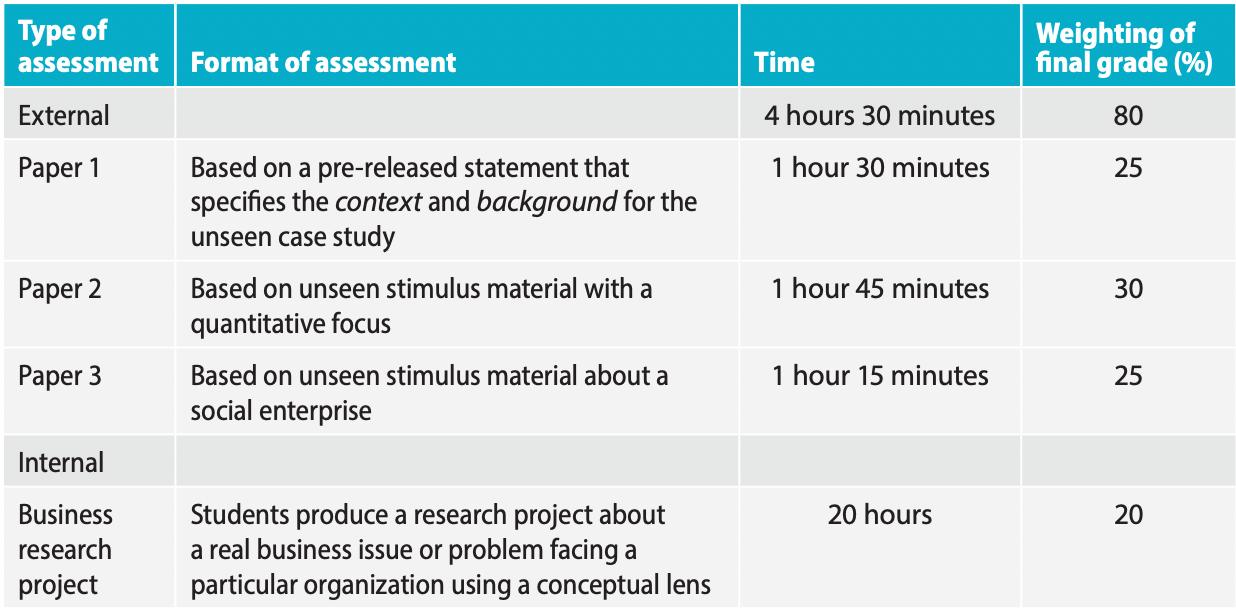
Source: International Baccalaureate Subject Brief : Business Management SL
Mastering the IB Business Management IA at the Higher Level demands a strategic approach, combining an insightful research question with robust analysis and evaluation. The examples and guidance outlined in this post provide a solid foundation for students. However, consider leveraging the expertise such as IB tutoring . Such personalized support can significantly enhance your understanding and skills, leading to not only a successful IA but also a deeper comprehension of business management principles, which is invaluable in your academic journey and beyond.
Need Expert IB Help?
If you’re looking for assistance with your internal assessment, get in touch with the TutorChase team and we’ll be able to provide you with an expert IB Business Management tutor. We’ll be there every step of the way!

Professional tutor and Cambridge University researcher

Written by: Charles Whitehouse
Charles scored 45/45 on the International Baccalaureate and has six years' experience tutoring IB and IGCSE students and advising them with their university applications. He studied a double integrated Masters at Magdalen College Oxford and has worked as a research scientist and strategy consultant.
Related Posts

IB Business Management IA SL: 60 Examples and Guidance

What are the Easiest IB Subjects?

Preparing for the May 2024 IB Exams

Hire a tutor
Please fill out the form and we'll find a tutor for you
- Select your country
- Afghanistan
- Åland Islands
- American Samoa
- Antigua and Barbuda
- Bosnia and Herzegovina
- Bouvet Island
- British Indian Ocean Territory
- Brunei Darussalam
- Burkina Faso
- Cayman Islands
- Central African Republic
- Christmas Island
- Cocos (Keeling) Islands
- Congo, The Democratic Republic of the
- Cook Islands
- Cote D'Ivoire
- Czech Republic
- Dominican Republic
- El Salvador
- Equatorial Guinea
- Falkland Islands (Malvinas)
- Faroe Islands
- French Guiana
- French Polynesia
- French Southern Territories
- Guinea-Bissau
- Heard Island and Mcdonald Islands
- Holy See (Vatican City State)
- Iran, Islamic Republic Of
- Isle of Man
- Korea, Democratic People'S Republic of
- Korea, Republic of
- Lao People'S Democratic Republic
- Libyan Arab Jamahiriya
- Liechtenstein
- Macedonia, The Former Yugoslav Republic of
- Marshall Islands
- Micronesia, Federated States of
- Moldova, Republic of
- Netherlands
- Netherlands Antilles
- New Caledonia
- New Zealand
- Norfolk Island
- Northern Mariana Islands
- Palestinian Territory, Occupied
- Papua New Guinea
- Philippines
- Puerto Rico
- Russian Federation
- Saint Helena
- Saint Kitts and Nevis
- Saint Lucia
- Saint Pierre and Miquelon
- Saint Vincent and the Grenadines
- Sao Tome and Principe
- Saudi Arabia
- Serbia and Montenegro
- Sierra Leone
- Solomon Islands
- South Africa
- South Georgia and the South Sandwich Islands
- Svalbard and Jan Mayen
- Switzerland
- Syrian Arab Republic
- Taiwan, Province of China
- Tanzania, United Republic of
- Timor-Leste
- Trinidad and Tobago
- Turkmenistan
- Turks and Caicos Islands
- United Arab Emirates
- United Kingdom
- United States
- United States Minor Outlying Islands
- Virgin Islands, British
- Virgin Islands, U.S.
- Wallis and Futuna
- Western Sahara

Still have questions? Let’s get in touch.
- Feb 27, 2023
- 11 min read
The EXACT Structure you need for a 7 in your Business Management IA
Updated: Feb 28, 2023

The Business Management IA assesses students' ability to analyze businesses, use business tools, and collect data. However, due to the vague criteria for the IA, many students find it highly challenging. It shocking the number of students that perform poorly in the IA. But we are here to change that!
In this blog, I will outline the IA structure that has been used time and time again by our tutors to achieve high marks in the Business IA. Following this guide as strictly as possible and I am certain you will get a 7.
Before we dive into the IA's structure, let's briefly discuss the IA in general.
Business IA General Overview
For HL students, the IA accounts for 25% of their final grade, making it the most crucial assessment piece.
The primary distinction between the HL and SL IA is that HL students need to analyze a forward-thinking business decision, whereas SL students need to write a commentary on a business's operations.
Most importantly, the HL IA heavily relies on primary data, while SL students have the option to solely collect secondary data. Let's examine examples of SL and HL research questions to further illustrate this distinction.
SL Research Question:
How have Google's changes in organizational structure and leadership style affected its corporate culture, employee productivity, and efficiency?
Please note that SL students can choose large businesses since primary market research is not a priority.
HL Research Question:
Should TNN invest in a laser cutter to decrease costs and gain control over operations in an attempt to increase revenue and overall profitability?
Note that "TNN" is not a massive Fortune 500 company, so it is possible to collect valuable primary data. Additionally, the question is forward-facing, meaning the IA will evaluate the pros and cons of a potential business decision.
The Business IA consists of two separate reports. The first report is the "Research Proposal," where students justify and plan their research. The second document is the actual IA, where students analyze all the data and evaluate their business decision.
How to structure a Level 7 business IA
Research Proposal (Total 500 Words)
The research proposal is the precursor to the IA and should be written in the future tense as the primary research has yet to be conducted.
Research Proposal Title Page
State your Research Questions
The session number, e.g., Nov22
Research Question
The research question is one of the most important parts of your IA; therefore, it is worthwhile to write a good one from the start. Here are a few points to refine your research questions:
Always state the name of the business in the form of an abbreviation.
Always include a list of criteria that you will use to evaluate the business decision.
For example, in the following research question:
“Should TNN invest in a laser cutter to decrease costs and gain control over operations, in an attempt to increase revenue and overall profitability?”
The criteria that will be evaluated are the revenue and profitability increase of this plan.
Other aspects you should avoid are:
Making an IA that is heavily dependent on the industry rather than the company
Being too broad with your research questions
IAs that require information you do not have access to
Choosing to focus on an IA that is not prevalent in the IB syllabus
2. Rationale (~150 Words)
Give a summary of the business
What type of business is it? Private limited? Un-incorporated?
What are its main operations?
What are its values and mission?
What is your justification for choosing this business?
Outline the problem that the business is facing.
What is the potential solution that is looking to be implemented? Why has this not been implemented in the past?
3. Theoretical Framework
Make a table and list the topics that will be covered in your IA.
Make a justification column explaining why this topic is needed in your IA.
TIP: Be selective with the tools that you are using. Using too many means that you will spread your word count too thin and not be able to do in-depth analysis.
4. Methodology
Include all the sources of primary and secondary data, along with why you have included them.
Use multiple sources of primary data. This will help you in Criteria B.
TIP: Include as many primary sources as possible, even if you are only going to refer to them once.
5. Anticipated Difficulties
Talk about difficulties that are industry and business-specific along with potential solutions.
Avoid mentioning obvious problems and those that are within your control.
Eg: “It will be hard to arrange a meeting with the CEO.” This is not a good difficulty as you can rearrange to a more convenient time.
6. Action Plan
Use a Gantt Chart to show the dates of each task.
Create the base model in excel.
Always include modifications as it shows that you actually used the graph.
TIP: For this page only, change the layout to landscape. This is the only way to fit the whole chart on one page.
Business Written Report (Total word count: 2000)
The written report is the main component of your IA. It should be written in the past tense since you have already conducted your research and analysis. As there is no page limit for business IAs, I highly recommend double spacing. This will increase the legibility of your IA.
1. Title Page
Include research questions, session number, executive summary word count, and the main IA word count.
The page number should restart from 1 on this page.
2. Acknowledgment
Write a relatively short paragraph expressing your gratitude. This is not needed in the IA and does not count in the word count.
3. Table of Contents
The table of contents should only include the major headings, i.e., all the numbered points in this list.
The table of contents must start with the executive summary at the top. TIP: It is easier if you complete this page as one of the last parts of your IA.
4. Executive Summary (200 words, excluded from your report's word count)
TIP: This section provides an extremely condensed version of your IA, and the key is to use a high concentration of business terminology. Read through a business paper 1 case-study to get an idea of the level of detail expected.
TIP: Leave this section until last, after finishing your entire IA.
TIP: Divide the summary into three short paragraphs:
Quickly summarize the business and the issue that has arisen.
Briefly state all primary and secondary data that was used, as well as any other business tools employed for analysis.
Briefly summarize the conclusion and main recommendations. Also, mention a brief line about the assumptions and limitations of your findings.
5. Introduction (~150 Words)
TIP: The introduction is very similar to the rationale. It's not a bad idea to rewrite your rationale.
Include the company name and abbreviation.
State and explain the company’s operations.
Outline current strategic goals.
Explain the problem the business is facing and propose a potential solution.
Describe what prevented the company from implementing this solution in the past.
At the end, include your research question and justify how you reached it.
6. Methodology (~150 Words)
TIP: This section is dedicated to giving a brief outline of the research and data you have collected.
State the primary and secondary sources you used, e.g., “Interview with the owner, survey with customers, and observations at competitors.”
Make sure to emphasize the wide range of primary data you are using.
Discuss all the business tools you will be using and briefly justify why you are using them.
Mention any changes that you made to the method throughout the IA.
7. Limitations (~100 Words)
The limitation is aimed to discuss how valid your data is.
Include 2 or 3 points that may affect the reliability of your data. Some examples are:
Subjectivity in qualitative business analysis.
Financial data during times of a recession/boom may not be representative of regular business activity.
Customers of the workplace may be intentionally biased.
8. Main Results and Findings (~300 Words)
In this section, you will state all the data you have collected. Summarize all the qualitative data and calculate all the quantitative data.
Include a brief summary of the interview, with footnotes referring to the answers you are summarizing.
Include 2 or 3 graphs of the survey that you conducted. Only include necessary graphs in the main body of the document. Place all other graphs in the appendix and refer to them through footnotes.
Include all investment appraisal and financial ratio calculations. It is good practice to write the equation for all calculations that you do. In addition, all the financial information needs to be cited using footnotes.
Tip: If you are calculating ARR, I highly recommend using the table method. This is the most visually clear way of presenting calculations, especially if you are dealing with variable annual cash flow.
The main point to keep in mind is that all data, whether financial, quantitative, or qualitative, needs to be cited in the appendix using footnotes.
9. Analysis and Discussion (~1100 Words)
TIP: This criterion accounts for the largest number of marks, so spend the most amount of time dedicated to analyzing and evaluating. Here, analyze the data using business theory and assess if it supports or opposes the proposed research question's change. Analyze all the implications of the data in a sequential and coherent manner. For every different tool and primary research method that is used, you should dedicate a separate analysis section to it.
This section is where many students struggle, so here is a potential structure you can use:
Apply the theory and terminology from the business textbook when analyzing data.
Ensure that all analysis points are linked to the impact on internal and external stakeholders. For the main analysis section, it is recommended to use the 'snowball method', which is used in the mark schemes of business paper 1s. This method will be outlined below.
Conclude each section with a brief analysis of whether the tool supports or opposes the business decision, taking into consideration whether it is for the short or long term.
Add a section at the end of every tool where you discuss the limitations of the tool. For instance, for the Lewin's force field analysis, the ranking for the driving and restricting factors is subjective; this bias needs to be accounted for through the use of quantitative tools.
Always analyze the qualitative tools first then the quantitative tools as the qualitative data provides context to the reader.
10. Conclusion (~100 Words)
In the conclusion, you need to combine all the mini-conclusions together and evaluate if the short-term disadvantages out weight the long-term advantages or vice-versa.
State all the tools that are in support of the business decision and all the tools that are against it. long-term. Imagine a table
Note: Do not include a table. You must explain the same concept in written form
As seen above, most tools support the decision, while some are against it. You must discuss and justify why the change must be implemented despite the disapproving interview and investment appraisal results. This process of weighing up the pros and cons will favorable for the evaluation and critical thinking criteria. ii. Discuss the limitations of your research; components that may have prevented you from reaching an established conclusion
11. Recommendation (~100 Words)
Limit your recommendations to three to ensure that you provide sufficient detail within the word count limits. Furthermore, ensure that your recommendations are coherent with your conclusion.
Provide recommendations for short-term actions (0-1 years) that the business can take to achieve quick results. These could range from contacting suppliers to making new investments.
Provide recommendations for long-term objectives (2-5 years). What can the business do to continue growing and profiting?
Include at least one recommendation for gathering additional information and conducting research. This additional research should be aligned with the limitations outlined earlier in the IA.
12. Bibliography
Alphabetize your sources
The format of the bibliography and citation is not relevant; however, it needs to be consistent throughout the IA.
13. Appendix
Include all primary data sources
Include all graphs and scripts of interviews
All financial data collected directly from the company also needs to be here.
As you write your IA, I highly encourage you to keep this blog open and add the following sections as you go. It is essential to include all these points, especially if you are aiming for a 7.
How to Analyze and Evaluate like a Level 7 Business Student (The Snowball Method)
The snowball method for analysis is something I came up with while I was in grade 12. It consistently allowed me to score in the high 80s in my business papers 1s and 2s. If you read any business paper 2 example answer, you will not find detailed and isolated discussions regarding single topics such as cash flow. Instead, you will find fluid analysis created by a chain of implications.
By a chain of implications, I mean constantly asking yourself the question: "So what? What is impacted by this change? Who will be affected? Why does it matter?" These are all important questions that you need to address in your analysis. The best way to do this is to continuously ask "so what" over and over again, hence why it is called the snowball method. Let's go over an example:
Imagine you are the owner of a school that lacks well-trained teachers. As a result, customer satisfaction has been low. The proposed solution is to increase the training of the teachers.
A low-level and one-dimensional analysis would be:
"Increasing teacher training would improve service quality, hence would improve customer satisfaction."
This analysis lacks sophistication and has a poor spread of business terminology. A high-quality analysis would discuss additional content, which continuously flows. See the example below.
“Implementing teacher training will result in more skilled teachers who are more motivated as suggested by the mastery component of Daniel Pink's theory of motivation. This change will likely have a positive impact on the school's corporate culture and reduce the school's labor turnover . Additionally, having specialized and highly skilled teachers will make it easier for the school to implement on-the-job training in the future, reducing training costs in the long term.”
The analysis represented as a continuous chain:
Implementing teacher training → more skilled teachers → increased motivation (Daniel Pink) → improved corporate culture → low labor turnover → teachers stay for longer at the school, gaining more experience and becoming more specialized → easier to implement on-the-job training → reducing training costs over the long term
As you can see, the second analysis discusses far more implications of the business decision and includes a high density of business terminology. This is the type of analysis you should be looking to replicate. Try to create a chain of events, showing where each business decision leads and how the effects trickle down to stakeholders.
I would highly encourage you to attempt to discuss as many business concepts as possible, at least those that are relevant to the IA. As a general guide, regardless of your proposed change, you must, to some extent, discuss the impact it will have on HR, operations, marketing, and finance.
Another important tip is to add variety to your analysis. Avoid having "an increase in profitability" as the outcome of all your analysis. This will be seen as one-dimensional by the IB markers, and you will be penalized in the analysis and evaluation criteria. Instead, try to discuss the impact your business decision will have on cash flow, revenue, working capital, working capital cycle, fixed and variable costs, short-term and long-term capital expenses, and more. The list goes on. Many low-performing business IAs tend to be hyper-focused on profit. Make your analysis multi-dimensional and discuss other components as well.
How to Layout a Level 7 Business IA
Unlike other IAs, the Business IA is lengthy. Therefore, it is crucial to have a good layout. Moreover, the layout accounts for 4 marks in the IA criteria, which could be the difference between a 7 and a 6.
I highly recommend using footnotes as a citation method. This will not only save you words, but it will also allow you to easily reference all your primary data.
Important note: In your IA, whenever you refer to primary data, it must be cited using footnotes. This includes all financial data used for investment appraisal and driving and restraining forces for Lewin's force field diagrams.
Be specific with your appendix references, particularly for the interview. Do not ambiguously state (Appendix 1: interview), instead say something like (Appendix 1: Interview with the owner - question 7). This layout can be seen in the image below.

2. Double-space your IA. This will help with legibility in your IA.
Make sure to have clean headings with few aesthetic features.
Font size should be 12 or 13 Arial, making sure it is consistent throughout the IA.
Make sure to bold and italicize important concepts that you want the marker to pay attention to.
3. Always caption your diagrams and include table headings. These headings should not be vague and should be as detailed as possible.
Although the business IA is confronting, if done right, it can be one of the most intellectually challenging and fun experiences of your IB journey. As a past IB student who scored 80% overall in their finals, I can confidently say that if you include all these components in your IA, you will perform very well.
There is only so much advice I can provide you over a blog. For personalized feedback on your IA, sign up for our IA feedback service.
Best of luck!
Recent Posts
Key Concept in Economics IA
Avoid These Overused TOK Essay Examples
Deconstructing a 10/10 TOK Essay from Introduction to Conclusion

50+ IB Business Management IA Ideas
Request free trial class, ib business management hl ia ideas.
This list of IB Business HL IA ideas is a helpful resource for students seeking inspiration and guidance in their coursework. The IA questions along with the details is a research project that accounts for 25% of the total grade for Business HL students and is based on primary research obtained from the organization under investigation. The list includes a wide range of topics and ia questions, such as the impact of globalization on small businesses, the role of ethics in business decision making, and the effects of technological advancements on the job market. By selecting a strong topic and conducting thorough research and planning, students can create a standout IA that showcases their understanding of business concepts and theories. Additionally, students can find high-scoring IB Business and Management Internal Assessment examples to further enhance their understanding and improve their own work.
1.) What marketing strategies should D-Mart supermarkets use to increase their sales revenue in Pune?
Research question:.
What marketing strategies should D-Mart supermarkets use to increase their sales revenue in Pune?
Area of Syllabus:
Marketing (The four Ps, Extended Marketing Mix)
Methodology:
Interview with the manager, Survey with customers, Observation at the store
Organizational Tools:
SWOT Analysis, Profit and Loss Account, Ratio Analysis, 7P’s of Marketing mix
Recommendation:
Invest in radio, television advertising, digital marketing and e-commerce. Open stores in shopping malls to attract more customers. Use direct, viral, social media, and guerrilla marketing.
2.) To what extent, and how should the employee motivation at Sonigara Builders be increased in Pune?
To what extent, and how should the employee motivation at Sonigara Builders be increased in Pune?
Human Resource Management (Planning, Motivation, Stakeholders, Leadership, Organizational Culture, Employee and Employer Relations)
Interview with the owner, Company’s Website, Interview employees
Organizational Tools:
Motivation Theories – Taylor and Maslow, Financial and Non-Financial Rewards, SWOT Analysis
Sonigara Builders should seek to motivate their workforce to maximize job satisfaction, staff morale and labor productivity by financial rewards (salary, wages, commission, performance-related pay, perks) and non-financial rewards (job enrichment, job rotation, encourage teamwork).
3.) Should Sante Spa restaurant set up a new branch in order to maximize their profitability?
Should Sante Spa restaurant set up a new branch in order to maximize their profitability?
Operations Management (Quality Management, Location, Research and Development), Marketing (Market Research, Extended Marketing Mix)
Interview owner, Observations at new branch location
Investment Appraisal (Payback Period), Decision Tree, SWOT Analysis, Force Field Analysis, Ansoff Matrix, Net Present Value
It is recommended that Sante Spa should consider setting up a new branch. It should go digital to leverage growth. Consider franchising, reinvent your product portfolio, focus on customer service, encourage learning and training sessions for employees. Lastly, build partnerships that enable growth.

4.) What are the consequences of Takur Bakery’s decision to restrain from rapid expansion of the company?
What are the consequences of Takur Bakery’s decision to restrain from rapid expansion of the company?
Growth and Evolution (Internal and External growth), Operations Management
Interview with the owner, Observations
SWOT Analysis, Force Field Analysis, STEEPLE Analysis, Balance Sheet
Thakur Bakery should look at advantages of expansion rather than restraining it from expansion. The consequences to restrain from expansion include the company will not grow, it will not secure larger market share, sales and profit will not increase, poor brand awareness. However the reasons for restraining from rapid expansion would be entry into new markets that require extensive market research and compete with well-established rivals.
5.) What expansion strategies should Bajaj use to expand its electric scooters business in the face of increasing demand in Pune?
What expansion strategies should Bajaj use to expand its electric scooters business in the face of increasing demand in Pune?
Growth and Evolution (Internal and External Growth)
Customer Survey, Observations at the showrooms, Interview with manager
Position Map, Investment Appraisal, SWOT Analysis, STEEPLE Analysis
Expansionary fiscal policy should be used to boost bajaj business activity. The government should provide subsidies and reduce taxes on electric vehicles because it’s sustainable for the environment. Businesses tend to require external finance to fund their expansion. Expansion strategies should include product development, increase customer base, diversification, increase brand awareness, recruit more workers, franchise new showrooms, use high-tech machinery.
6.) What promotional strategies should Cake Studio use to target a new market segment which emphasizes their USP?
What promotional strategies should Cake Studio use to target a new market segment which emphasizes their USP?
Marketing (Planning, Four Ps – Promotion: ATL and BTL)
Focus Groups, Observation
Organizational Tools:
4 P’s of Marketing Mix, Ansoff Matrix, Perception Map, BCG Matrix, AIDA Model
Prices could also be changed to attract different market segments. Cake Studio must be able to provide suitable products to cater for each market segment. The size and purchasing power of each market segment must be quantifiable. They should use mass marketing strategy to target market segments. The marketing strategies should focus on the uniqueness and exclusivity of the product. Promotion may need to take place on a large scale through above the line methods to attract a large number of potential customers.
7.) Should Suhana company undertake investment into ready to eat product lines in order to increase their market share and build a larger brand in the Indian Food Industry?
Should Suhana company undertake investment into ready to eat product lines in order to increase their market share and build a larger brand in the Indian Food Industry?
Marketing (Role, The Four Ps, Market Research)
Focus Groups
STEEPLE Analysis, Decision Tree, Investment Appraisal, Force Field
Yes definitely Suhana company should invest in ready-to-eat packets in order to increase their market share and build a larger brand in the Indian Food Industry. It should be segmented by product types (Instant Break, Soup and Snacks), distribution (Supermarkets, retailers) and geography(Asia-Pacific, South America). It should focus on packaging for promotion. It should constantly innovate products to meet and even preempt evolving needs. They should also focus on product development, market penetration and expansion of the sales channel. To increase demand, the firm should consider introducing loss leader pricing strategy in relation to ready-to-eat packets.
8.) How can Hi-Fi Gym improve its brand presence in Pune, India?
How can Hi-Fi Gym improve its brand presence in Pune, India?
Marketing (Branding, Promotion – ATL and BTL, Pricing)
Interview with owner, Customers Survey
SWOT Analysis, Position Map, Fishbone Diagram, BCG Matrix, STEEPLE Analysis Recommendation: Hi-Fi Gym should use branding to improve its brand presence in Pune by using several marketing strategies. It should franchise new branches in different locations. They should use psychological pricing by offering packages in months and years. It should focus on long-term goals and objectives. It should create brand identity, keep branding consistent, they should be authentic, offer value and focus on quality.
9.) How can Big Bazar supermarket increase its staff productivity?
How can Big Bazar supermarket increase its staff productivity?
Human Resource Management (Appraisal, Training, Leadership Style, Employer and employee relations)
Interview with HR Manager, Survey with employees
Taylor’s, Maslow’s, Profit and Loss Account, SWOT Analysis
It should change its leadership style. Since there is a communication problem between staff and managers, they should change their ways of dealing and treating employees. The managers should assign tasks and roles to staff. It should divide the staff and implement division of labour on a rotational basis to build teamwork. Staff should be appreciated for their hard-work through promotion or higher pay. On-site training should be provided to staff.
10.) What methods of motivation should Ranka Jewellers implement to retain staff?
What methods of motivation should Ranka Jewellers implement to retain staff?
Human Resource Management (Planning, Motivation, Leadership, Corporate culture, Employee and Employer relation)
Survey with employees to evaluate their level of satisfaction, Interview with owner of the company.
Maslow’s Hierarchy of needs, Non-Financial Rewards, SWOT Analysis
The work should be appreciated and employees should feel valued. This will encourage them to work harder for praise, keeping them motivated throughout. On-site training should be provided by business executives. Leadership style needs to be changed to situational. The company should reconsider the current employee positions in regards to their abilities and past experiences.
11.) What marketing strategies should Burger King use to expand their reach in the European market?
What marketing strategies should Burger King use to expand their reach in the European market?
Marketing (International marketing, Market segmentation, Targeting and positioning)
Secondary research (industry reports, competitor analysis), survey with potential customers in Europe, analysis of company’s current marketing efforts
SWOT Analysis, PESTEL Analysis, Marketing Mix, Market Research Tools
Focus on developing a strong digital marketing presence, tailor messaging and promotions to different segments of the European market, consider partnering with European retailers or distributors, attend industry trade shows to build awareness and generate leads.
12.) How can Wynn Resorts Ltd. reduce employee turnover in their call center?
How can Wynn Resorts Ltd. reduce employee turnover in their call center?
Human Resource Management (Recruitment and Selection, Training and Development, Motivation and Leadership)
Interviews with current and former employees, analysis of exit surveys, review of company policies and procedures, benchmarking against industry standards
SWOT Analysis, Job Analysis, Performance Appraisal, Employee Training and Development Programs, Leadership Theory
Develop and implement a comprehensive onboarding program for new employees, offer ongoing training and development opportunities, ensure that compensation and benefits packages are competitive with industry standards, establish a culture of open communication and feedback.
13.) What steps can Party City take to improve their supply chain efficiency?
What steps can Party City take to improve their supply chain efficiency?
Operations Management (Supply Chain Management, Quality Management, Process Analysis)
Site visits to suppliers and manufacturers, analysis of current inventory management systems, interviews with supply chain partners, benchmarking against industry standards
SWOT Analysis, Six Sigma, Lean Manufacturing, Total Quality Management, Inventory Management Systems
Invest in new inventory management systems and technology, streamline processes and eliminate bottlenecks, establish strong relationships with suppliers and manufacturers, conduct regular quality control checks.

14.) What pricing strategy should Yves Saint-Laurent use to increase market share in the luxury goods sector?
What pricing strategy should Yves Saint-Laurent use to increase market share in the luxury goods sector?
Marketing (Pricing Strategies, Market Segmentation)
Secondary research (industry reports, competitor analysis), focus groups with luxury goods consumers, analysis of company’s current pricing strategy
SWOT Analysis, Pricing Models (Cost-Plus, Value-Based, Penetration), Market Research Tools
Consider a penetration pricing strategy to gain market share, offer promotions or discounts to attract new customers, tailor pricing to different segments of the luxury goods market, focus on creating a perception of exclusivity and luxury.
15.) How can Malabar Gold & Diamonds improve their customer service to increase customer loyalty?
How can Malabar Gold & Diamonds improve their customer service to increase customer loyalty?
Marketing (Customer Relationship Management, Service Marketing)
Mystery shopping at company locations, analysis of customer service interactions, customer satisfaction surveys, benchmarking against industry standards
SWOT Analysis, CRM Software, Service Quality Measurement Tools, Complaint Management Systems
Implement a comprehensive training program for customer service employees, empower employees to make decisions and resolve issues on the spot, create a formal complaint management system, establish a loyalty program for repeat customers.
16.) What steps can Maruti Suzuki take to reduce their carbon footprint?
What steps can Maruti Suzuki take to reduce their carbon footprint?
Environmental Management (Sustainability, Corporate Social Responsibility)
Analysis of company’s energy and resource use, benchmarking against industry standards, consultation with environmental experts, review of government regulations
SWOT Analysis, Life Cycle Assessment, Environmental Management Systems, Carbon Accounting Tools
Develop and implement a sustainability plan with specific goals and targets, invest in renewable energy sources, reduce waste and implement recycling programs, use sustainable materials in products and packaging.
17.) How can TCS improve their team collaboration and communication?
How can TCS improve their team collaboration and communication?
Organizational Behavior (Team Dynamics, Communication, Leadership)
Surveys with employees, analysis of team communication patterns, review of company policies and procedures, benchmarking against industry standards
SWOT Analysis, Team Building Exercises, Communication Strategies, Leadership Development Programs
Implement regular team building exercises and activities, establish clear communication channels and protocols, provide training in effective communication and conflict resolution, develop and promote effective leadership practices.
18.) What marketing strategies should Raymond use to target the Gen Z demographic?
Marketing (Target Marketing, Consumer Behavior)
Focus groups with Gen Z consumers, analysis of social media trends and platforms, review of competitor strategies, benchmarking against industry standards
SWOT Analysis, Market Segmentation Strategies, Social Media Marketing Tools, Customer Relationship Management Software
Develop a strong social media presence and engage with Gen Z influencers, use targeted advertising on social media platforms, create content that speaks to Gen Z values and interests, offer personalized and interactive experiences.
19.) How can Costco improve their online sales and customer experience?
Marketing (E-commerce, Customer Experience Management)
Analysis of website user experience, surveys with online customers, benchmarking against industry standards, consultation with e-commerce experts
SWOT Analysis, Customer Journey Mapping, E-commerce Platform Analysis, Conversion Rate Optimization Tools
Invest in improving website user experience and functionality, optimize the customer journey from browsing to purchase, offer personalized recommendations and promotions, provide clear and transparent information about shipping and returns.
20.) To what extent does employee engagement affect organizational performance in Cognizant?
Organizational Behavior (Motivation, Job Satisfaction, Performance Management)
Surveys with employees and managers, analysis of performance metrics and employee turnover rates, benchmarking against industry standards, review of company policies and procedures
SWOT Analysis, Employee Engagement Surveys, Performance Management Frameworks, Total Rewards Programs
Develop and implement employee engagement initiatives such as recognition programs, career development opportunities, and work-life balance initiatives. Set clear performance goals and provide regular feedback and coaching to employees. Align total rewards programs with employee performance and organizational goals.
21.) How can Kovai Pazhamudir Nilayam improve their procurement process and reduce costs?
Business Management (Procurement Management, Cost Management)
Analysis of procurement processes, cost analysis, benchmarking against industry standards, consultation with procurement experts, review of government regulations
SWOT Analysis, Cost-Benefit Analysis, Procurement Performance Metrics, Contract Management Systems
Implement a strategic sourcing approach to reduce costs and improve supplier relationships. Conduct regular spend analysis to identify areas for cost savings. Use data analytics to optimize procurement processes. Develop and implement effective contract management systems to improve supplier performance and reduce risk.
22.) What factors contribute to customer loyalty in Popeyes and how can they be improved?
Marketing (Customer Relationship Management, Customer Experience Management)
Surveys with customers, analysis of customer feedback and complaints, benchmarking against industry standards, review of company policies and procedures
SWOT Analysis, Customer Journey Mapping, Net Promoter Score, Customer Relationship Management Software
Develop and implement a customer-centric culture within the organization. Provide personalized and engaging customer experiences at all touchpoints. Use customer feedback to continuously improve products and services. Offer loyalty programs and incentives to reward and retain customers.
23.) How can Himalaya diversify their product offerings and enter new markets?
Strategic Management (Diversification, Market Entry Strategies)
Analysis of market trends and opportunities, consultation with industry experts, review of company resources and capabilities, benchmarking against industry standards
SWOT Analysis, Porter’s Five Forces Analysis, Resource-Based View Analysis, Ansoff Matrix
Conduct market research to identify new product offerings and potential markets. Utilize partnerships and collaborations to enter new markets. Develop and acquire resources and capabilities necessary for new product offerings. Use a diversification strategy such as related or unrelated diversification.
24.) How can Zomato effectively manage their international human resources?
Human Resource Management (Global Human Resource Management, Cross-Cultural Management)
Surveys with international employees, analysis of cultural differences and practices, consultation with international HR experts, review of government regulations
Cross-Cultural Training Programs, International Performance Management Frameworks, International Compensation and Benefits Structures
Develop and implement cross-cultural training programs for employees and managers. Use international performance management frameworks to evaluate and develop employee performance. Develop international compensation and benefits structures that align with local practices and regulations.
25.) What steps can Party City take to improve their supply chain efficiency?
Business Ethics (Corporate Social Responsibility, Stakeholder Theory)
Analysis of company financial performance metrics, surveys with stakeholders, benchmarking against industry standards, review of company CSR policies and practices
SWOT Analysis, Stakeholder Mapping, Sustainability Reporting Frameworks, Triple Bottom Line Analysis
Integrate CSR practices into the company’s core business strategy. Develop and implement sustainability reporting frameworks to track and measure CSR impact. Align CSR practices with stakeholder expectations and industry standards. Communicate CSR efforts and impact to stakeholders and the public.
Download our Successful College Application Guide
Our Guide is written by counselors from Cambridge University for colleges like MIT and other Ivy League colleges.
To join our college counseling program, call at +918825012255
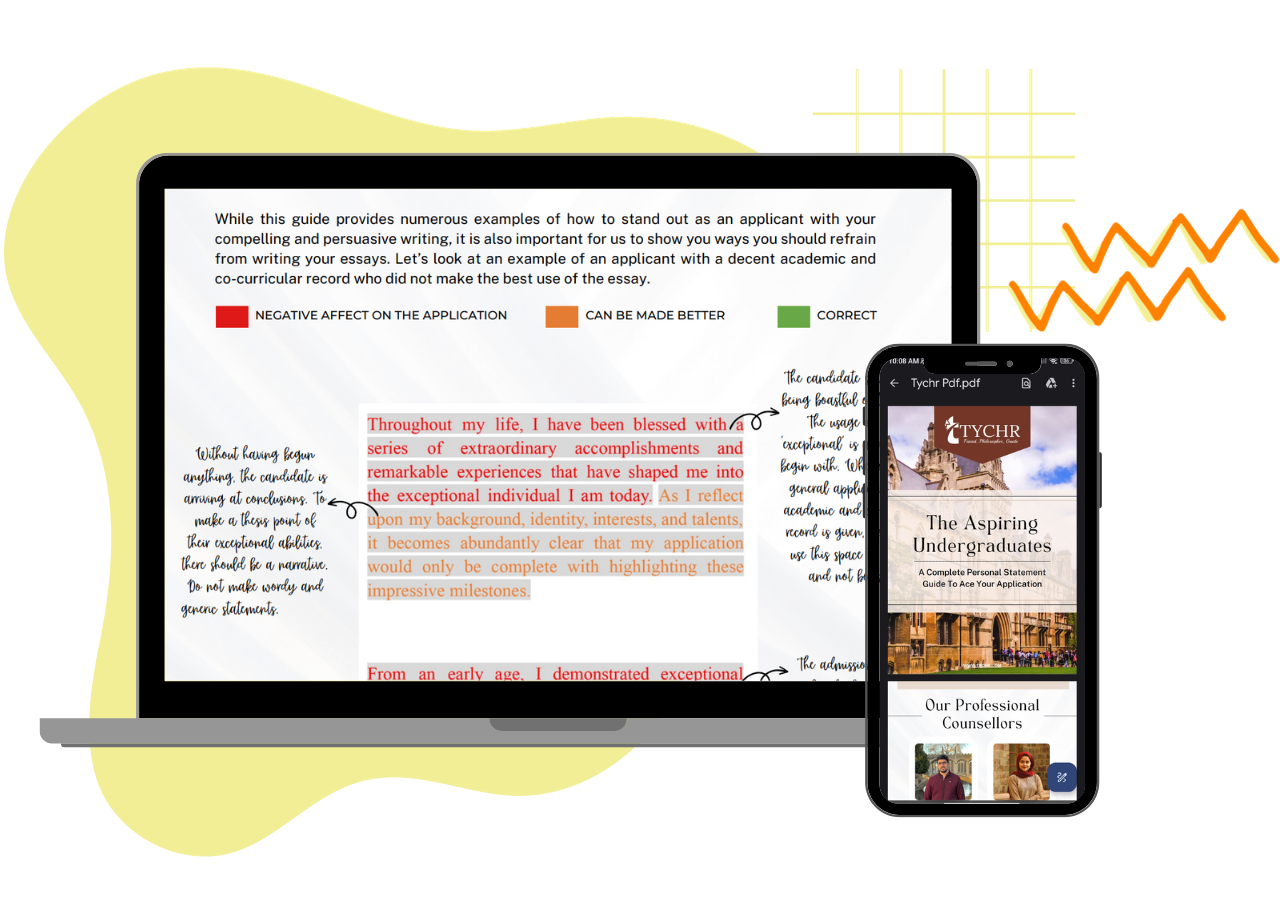
IB Business Management SL IA Ideas
This is a list IB Business Management SL IA ideas is a valuable resource for students to showcase their understanding of business concepts and theories. The IA is a research project that accounts for a significant portion of the grade, and students can choose from a wide range of topics and IA questions , such as globalisation, ethics, and technological advancements. Additionally, students can find high-scoring IB Business and Management Internal Assessment examples to improve their own work.
1.) What marketing strategies should Burger King use to expand their reach in the European market?
2.) how can wynn resorts ltd. reduce employee turnover in their call center, 3.) what steps can party city take to improve their supply chain efficiency, 4.) what pricing strategy should yves saint-laurent use to increase market share in the luxury goods sector, 5.) how can malabar gold & diamonds improve their customer service to increase customer loyalty, 6.) what steps can maruti suzuki take to reduce their carbon footprint, 7.) how can tcs improve their team collaboration and communication, 8.) what marketing strategies should raymond use to target the gen z demographic.
What marketing strategies should Raymond use to target the Gen Z demographic?
Don't forget to check our Forum
9.) how can costco improve their online sales and customer experience.
How can Costco improve their online sales and customer experience?
10.) To what extent does employee engagement affect organizational performance in Cognizant?
To what extent does employee engagement affect organizational performance in Cognizant?
11.) How can Kovai Pazhamudir Nilayam improve their procurement process and reduce costs?
How can Kovai Pazhamudir Nilayam improve their procurement process and reduce costs?
12.) What factors contribute to customer loyalty in Popeyes and how can they be improved?
What factors contribute to customer loyalty in Popeyes and how can they be improved?
13.) How can Himalaya diversify their product offerings and enter new markets?
How can Himalaya diversify their product offerings and enter new markets?
14.) How can Zomato effectively manage their international human resources?
How can Zomato effectively manage their international human resources?
15.) What impact does corporate social responsibility have on the financial performance of Bajaj Finance?
What impact does corporate social responsibility have on the financial performance of Bajaj Finance?
Our Expert Tutors!

Barbara Centis
Cat 1 – ESS and Cat 2 – Biology. Chief of the IB program. Mentored 320+ students across various curricula.

Dr Rashmi Kapoor
IBDP Cat 1 – Biology. Specializes in IBDP and A Levels Biology. 10+ years in Medicine with seasoned professionals.

Jacqueline Francis
IBDP Cat 1 – Business Management, IBDP Cat 1 – TOK. Taught over 130+ students across 4+ countries.

Dr. Nikita Bhan
IBDP Cat 1 & 2 November 2019. Specializes in Global Politics. Many students scored 7s; mentors 200+ students in assessments.

Shreya Narula
IBDP Cat 2 – English, IBDP Cat 2 – TOK. Qualifications as IB Examiner & Supervisor. Taught over 120+ students.

Sreevidya KG
IBDP Cat 1 – Chemistry, IBDP Cat 3 – IA Chemistry, IBDP Cat 1 – TOK. Helped 2 out of 3 students achieve a 7 in IB Chemistry.
Our Student'S Results
Score 40+ in IB Exam like they did
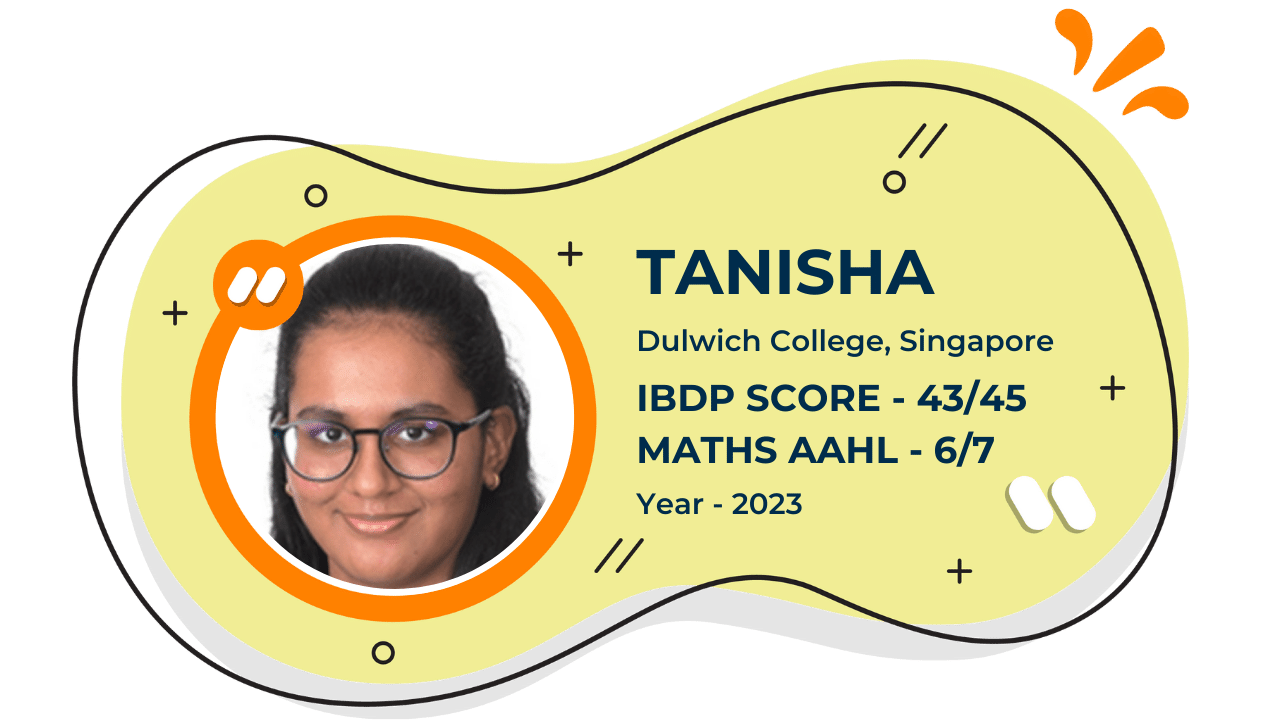
What our Students Have to say
A few words about us from our students…

IB Tutoring Recent Blogs
Give our blog a read for anything you need
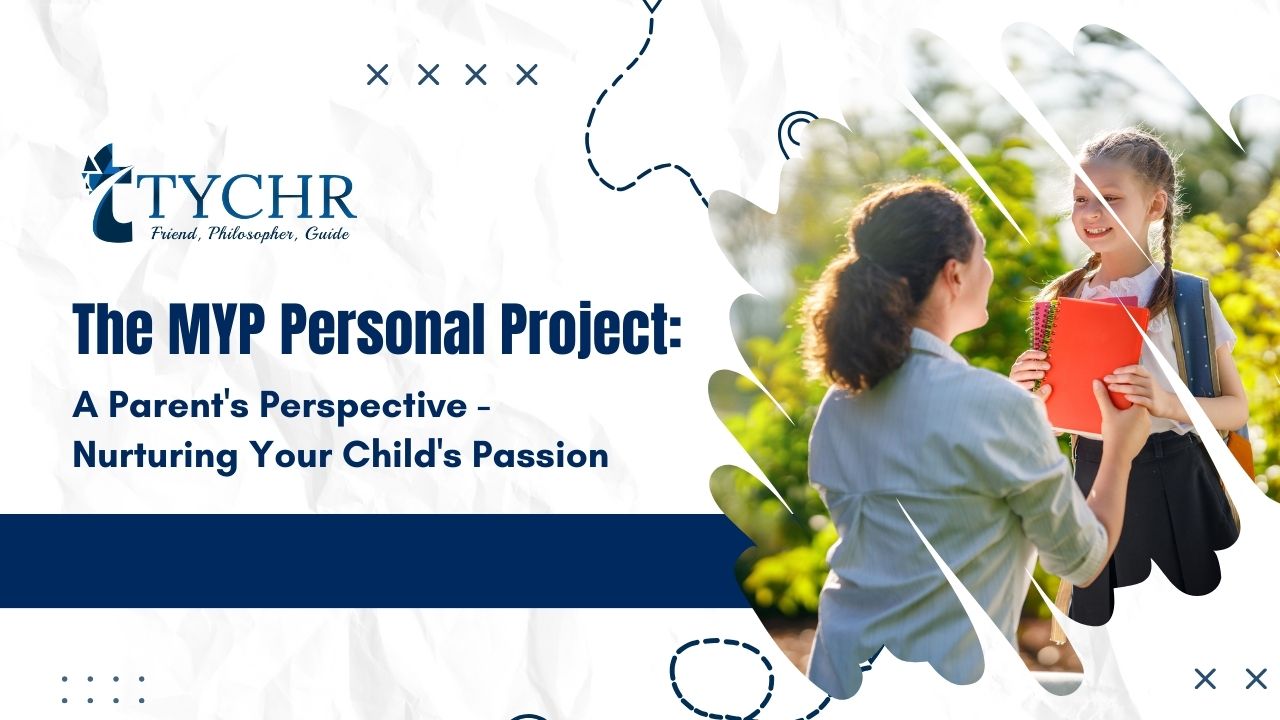
The MYP Personal Project: A Parent’s Perspective – Nurturing Your Child’s Passion

A SMOOTH PROGRESSION FROM IBMYP-1 TO IBMYP-5

Smooth Transition to IB-MYP: 10 Tips for Students and Parents

The Importance of Community Service in the IB Middle Years Programme (MYP): Nurturing Responsible Global Citizens

CAMBRIDGE VS IB-MYP
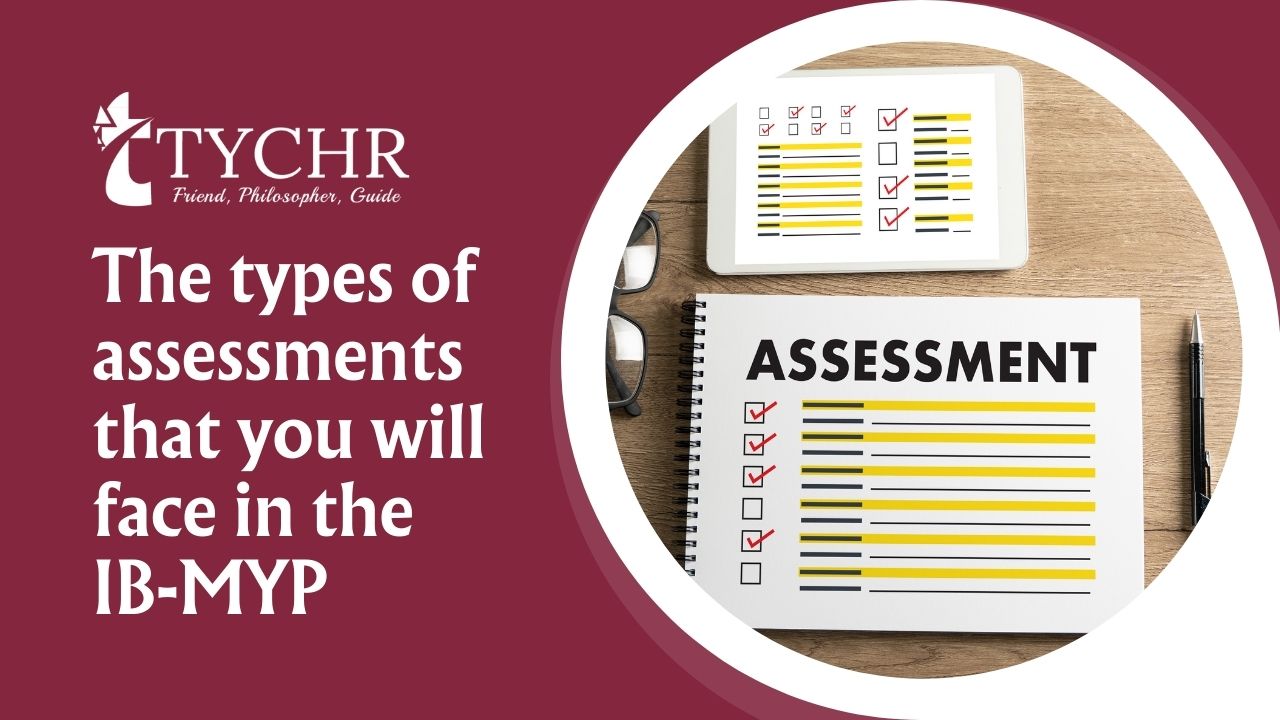
The types of assessments that you will face in the IB-MYP

IBMYP IN INDIA: Is it the right choice for you

Nurturing Effective Communication in the MYP: A Guide for Parents and Students
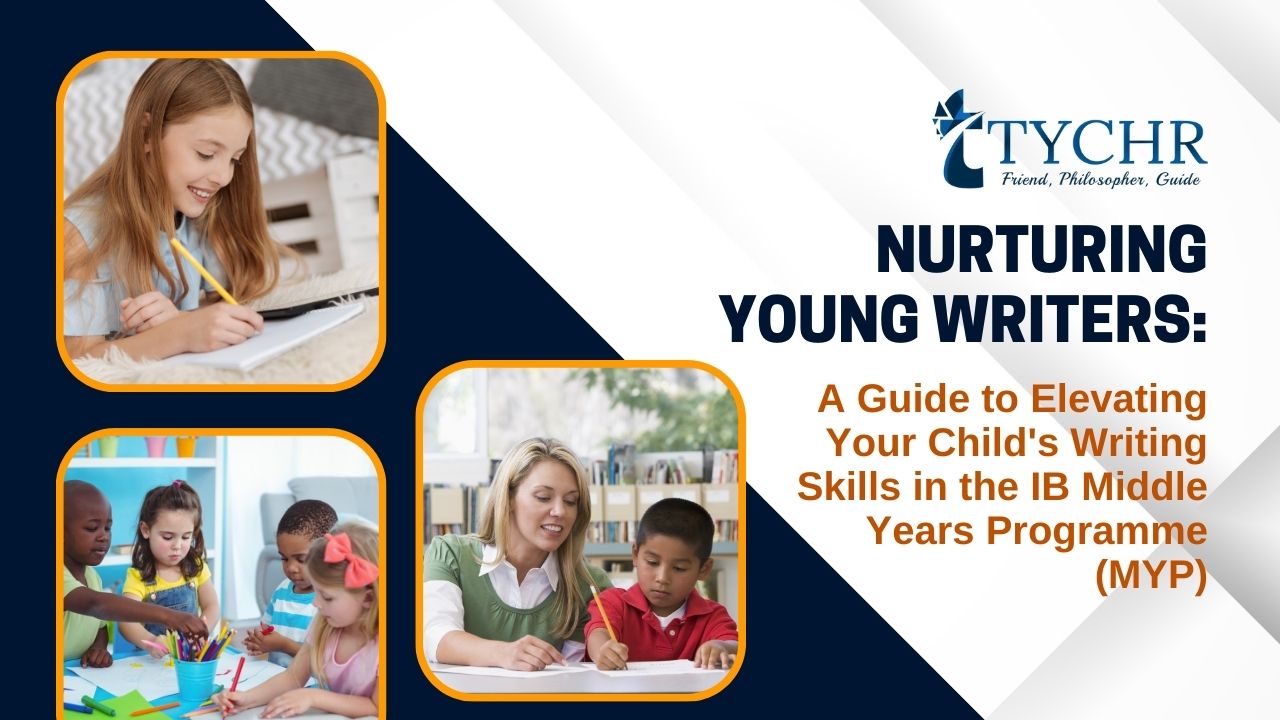
Nurturing Young Writers: A Guide to Elevating Your Child’s Writing Skills in the IB Middle Years Programme (MYP)

Guiding Your MYP Student’s Future: A Parent’s Conversational Toolkit
Get access to our free ib resources.

ANNOUNCEMENT
Download our Successful College Application Guide developed by counselors from the University of Cambridge for institutions like Oxbridge alongside other Ivy Leagues . To join our college counseling program, call at +918825012255
We are hiring a Business Development Associate and Content Writer and Social Media Strategist at our organisation TYCHR to take over the responsibility of conducting workshops and excelling in new sales territory. View More
Our approach
- Responsibility
- Infrastructure
- Try Meta AI
RECOMMENDED READS
- 5 Steps to Getting Started with Llama 2
- The Llama Ecosystem: Past, Present, and Future
- Introducing Code Llama, a state-of-the-art large language model for coding
- Meta and Microsoft Introduce the Next Generation of Llama
- Today, we’re introducing Meta Llama 3, the next generation of our state-of-the-art open source large language model.
- Llama 3 models will soon be available on AWS, Databricks, Google Cloud, Hugging Face, Kaggle, IBM WatsonX, Microsoft Azure, NVIDIA NIM, and Snowflake, and with support from hardware platforms offered by AMD, AWS, Dell, Intel, NVIDIA, and Qualcomm.
- We’re dedicated to developing Llama 3 in a responsible way, and we’re offering various resources to help others use it responsibly as well. This includes introducing new trust and safety tools with Llama Guard 2, Code Shield, and CyberSec Eval 2.
- In the coming months, we expect to introduce new capabilities, longer context windows, additional model sizes, and enhanced performance, and we’ll share the Llama 3 research paper.
- Meta AI, built with Llama 3 technology, is now one of the world’s leading AI assistants that can boost your intelligence and lighten your load—helping you learn, get things done, create content, and connect to make the most out of every moment. You can try Meta AI here .
Today, we’re excited to share the first two models of the next generation of Llama, Meta Llama 3, available for broad use. This release features pretrained and instruction-fine-tuned language models with 8B and 70B parameters that can support a broad range of use cases. This next generation of Llama demonstrates state-of-the-art performance on a wide range of industry benchmarks and offers new capabilities, including improved reasoning. We believe these are the best open source models of their class, period. In support of our longstanding open approach, we’re putting Llama 3 in the hands of the community. We want to kickstart the next wave of innovation in AI across the stack—from applications to developer tools to evals to inference optimizations and more. We can’t wait to see what you build and look forward to your feedback.
Our goals for Llama 3
With Llama 3, we set out to build the best open models that are on par with the best proprietary models available today. We wanted to address developer feedback to increase the overall helpfulness of Llama 3 and are doing so while continuing to play a leading role on responsible use and deployment of LLMs. We are embracing the open source ethos of releasing early and often to enable the community to get access to these models while they are still in development. The text-based models we are releasing today are the first in the Llama 3 collection of models. Our goal in the near future is to make Llama 3 multilingual and multimodal, have longer context, and continue to improve overall performance across core LLM capabilities such as reasoning and coding.
State-of-the-art performance
Our new 8B and 70B parameter Llama 3 models are a major leap over Llama 2 and establish a new state-of-the-art for LLM models at those scales. Thanks to improvements in pretraining and post-training, our pretrained and instruction-fine-tuned models are the best models existing today at the 8B and 70B parameter scale. Improvements in our post-training procedures substantially reduced false refusal rates, improved alignment, and increased diversity in model responses. We also saw greatly improved capabilities like reasoning, code generation, and instruction following making Llama 3 more steerable.

*Please see evaluation details for setting and parameters with which these evaluations are calculated.
In the development of Llama 3, we looked at model performance on standard benchmarks and also sought to optimize for performance for real-world scenarios. To this end, we developed a new high-quality human evaluation set. This evaluation set contains 1,800 prompts that cover 12 key use cases: asking for advice, brainstorming, classification, closed question answering, coding, creative writing, extraction, inhabiting a character/persona, open question answering, reasoning, rewriting, and summarization. To prevent accidental overfitting of our models on this evaluation set, even our own modeling teams do not have access to it. The chart below shows aggregated results of our human evaluations across of these categories and prompts against Claude Sonnet, Mistral Medium, and GPT-3.5.

Preference rankings by human annotators based on this evaluation set highlight the strong performance of our 70B instruction-following model compared to competing models of comparable size in real-world scenarios.
Our pretrained model also establishes a new state-of-the-art for LLM models at those scales.

To develop a great language model, we believe it’s important to innovate, scale, and optimize for simplicity. We adopted this design philosophy throughout the Llama 3 project with a focus on four key ingredients: the model architecture, the pretraining data, scaling up pretraining, and instruction fine-tuning.
Model architecture
In line with our design philosophy, we opted for a relatively standard decoder-only transformer architecture in Llama 3. Compared to Llama 2, we made several key improvements. Llama 3 uses a tokenizer with a vocabulary of 128K tokens that encodes language much more efficiently, which leads to substantially improved model performance. To improve the inference efficiency of Llama 3 models, we’ve adopted grouped query attention (GQA) across both the 8B and 70B sizes. We trained the models on sequences of 8,192 tokens, using a mask to ensure self-attention does not cross document boundaries.
Training data
To train the best language model, the curation of a large, high-quality training dataset is paramount. In line with our design principles, we invested heavily in pretraining data. Llama 3 is pretrained on over 15T tokens that were all collected from publicly available sources. Our training dataset is seven times larger than that used for Llama 2, and it includes four times more code. To prepare for upcoming multilingual use cases, over 5% of the Llama 3 pretraining dataset consists of high-quality non-English data that covers over 30 languages. However, we do not expect the same level of performance in these languages as in English.
To ensure Llama 3 is trained on data of the highest quality, we developed a series of data-filtering pipelines. These pipelines include using heuristic filters, NSFW filters, semantic deduplication approaches, and text classifiers to predict data quality. We found that previous generations of Llama are surprisingly good at identifying high-quality data, hence we used Llama 2 to generate the training data for the text-quality classifiers that are powering Llama 3.
We also performed extensive experiments to evaluate the best ways of mixing data from different sources in our final pretraining dataset. These experiments enabled us to select a data mix that ensures that Llama 3 performs well across use cases including trivia questions, STEM, coding, historical knowledge, etc.
Scaling up pretraining
To effectively leverage our pretraining data in Llama 3 models, we put substantial effort into scaling up pretraining. Specifically, we have developed a series of detailed scaling laws for downstream benchmark evaluations. These scaling laws enable us to select an optimal data mix and to make informed decisions on how to best use our training compute. Importantly, scaling laws allow us to predict the performance of our largest models on key tasks (for example, code generation as evaluated on the HumanEval benchmark—see above) before we actually train the models. This helps us ensure strong performance of our final models across a variety of use cases and capabilities.
We made several new observations on scaling behavior during the development of Llama 3. For example, while the Chinchilla-optimal amount of training compute for an 8B parameter model corresponds to ~200B tokens, we found that model performance continues to improve even after the model is trained on two orders of magnitude more data. Both our 8B and 70B parameter models continued to improve log-linearly after we trained them on up to 15T tokens. Larger models can match the performance of these smaller models with less training compute, but smaller models are generally preferred because they are much more efficient during inference.
To train our largest Llama 3 models, we combined three types of parallelization: data parallelization, model parallelization, and pipeline parallelization. Our most efficient implementation achieves a compute utilization of over 400 TFLOPS per GPU when trained on 16K GPUs simultaneously. We performed training runs on two custom-built 24K GPU clusters . To maximize GPU uptime, we developed an advanced new training stack that automates error detection, handling, and maintenance. We also greatly improved our hardware reliability and detection mechanisms for silent data corruption, and we developed new scalable storage systems that reduce overheads of checkpointing and rollback. Those improvements resulted in an overall effective training time of more than 95%. Combined, these improvements increased the efficiency of Llama 3 training by ~three times compared to Llama 2.
Instruction fine-tuning
To fully unlock the potential of our pretrained models in chat use cases, we innovated on our approach to instruction-tuning as well. Our approach to post-training is a combination of supervised fine-tuning (SFT), rejection sampling, proximal policy optimization (PPO), and direct preference optimization (DPO). The quality of the prompts that are used in SFT and the preference rankings that are used in PPO and DPO has an outsized influence on the performance of aligned models. Some of our biggest improvements in model quality came from carefully curating this data and performing multiple rounds of quality assurance on annotations provided by human annotators.
Learning from preference rankings via PPO and DPO also greatly improved the performance of Llama 3 on reasoning and coding tasks. We found that if you ask a model a reasoning question that it struggles to answer, the model will sometimes produce the right reasoning trace: The model knows how to produce the right answer, but it does not know how to select it. Training on preference rankings enables the model to learn how to select it.
Building with Llama 3
Our vision is to enable developers to customize Llama 3 to support relevant use cases and to make it easier to adopt best practices and improve the open ecosystem. With this release, we’re providing new trust and safety tools including updated components with both Llama Guard 2 and Cybersec Eval 2, and the introduction of Code Shield—an inference time guardrail for filtering insecure code produced by LLMs.
We’ve also co-developed Llama 3 with torchtune , the new PyTorch-native library for easily authoring, fine-tuning, and experimenting with LLMs. torchtune provides memory efficient and hackable training recipes written entirely in PyTorch. The library is integrated with popular platforms such as Hugging Face, Weights & Biases, and EleutherAI and even supports Executorch for enabling efficient inference to be run on a wide variety of mobile and edge devices. For everything from prompt engineering to using Llama 3 with LangChain we have a comprehensive getting started guide and takes you from downloading Llama 3 all the way to deployment at scale within your generative AI application.
A system-level approach to responsibility
We have designed Llama 3 models to be maximally helpful while ensuring an industry leading approach to responsibly deploying them. To achieve this, we have adopted a new, system-level approach to the responsible development and deployment of Llama. We envision Llama models as part of a broader system that puts the developer in the driver’s seat. Llama models will serve as a foundational piece of a system that developers design with their unique end goals in mind.

Instruction fine-tuning also plays a major role in ensuring the safety of our models. Our instruction-fine-tuned models have been red-teamed (tested) for safety through internal and external efforts. Our red teaming approach leverages human experts and automation methods to generate adversarial prompts that try to elicit problematic responses. For instance, we apply comprehensive testing to assess risks of misuse related to Chemical, Biological, Cyber Security, and other risk areas. All of these efforts are iterative and used to inform safety fine-tuning of the models being released. You can read more about our efforts in the model card .
Llama Guard models are meant to be a foundation for prompt and response safety and can easily be fine-tuned to create a new taxonomy depending on application needs. As a starting point, the new Llama Guard 2 uses the recently announced MLCommons taxonomy, in an effort to support the emergence of industry standards in this important area. Additionally, CyberSecEval 2 expands on its predecessor by adding measures of an LLM’s propensity to allow for abuse of its code interpreter, offensive cybersecurity capabilities, and susceptibility to prompt injection attacks (learn more in our technical paper ). Finally, we’re introducing Code Shield which adds support for inference-time filtering of insecure code produced by LLMs. This offers mitigation of risks around insecure code suggestions, code interpreter abuse prevention, and secure command execution.
With the speed at which the generative AI space is moving, we believe an open approach is an important way to bring the ecosystem together and mitigate these potential harms. As part of that, we’re updating our Responsible Use Guide (RUG) that provides a comprehensive guide to responsible development with LLMs. As we outlined in the RUG, we recommend that all inputs and outputs be checked and filtered in accordance with content guidelines appropriate to the application. Additionally, many cloud service providers offer content moderation APIs and other tools for responsible deployment, and we encourage developers to also consider using these options.
Deploying Llama 3 at scale
Llama 3 will soon be available on all major platforms including cloud providers, model API providers, and much more. Llama 3 will be everywhere .
Our benchmarks show the tokenizer offers improved token efficiency, yielding up to 15% fewer tokens compared to Llama 2. Also, Group Query Attention (GQA) now has been added to Llama 3 8B as well. As a result, we observed that despite the model having 1B more parameters compared to Llama 2 7B, the improved tokenizer efficiency and GQA contribute to maintaining the inference efficiency on par with Llama 2 7B.
For examples of how to leverage all of these capabilities, check out Llama Recipes which contains all of our open source code that can be leveraged for everything from fine-tuning to deployment to model evaluation.
What’s next for Llama 3?
The Llama 3 8B and 70B models mark the beginning of what we plan to release for Llama 3. And there’s a lot more to come.
Our largest models are over 400B parameters and, while these models are still training, our team is excited about how they’re trending. Over the coming months, we’ll release multiple models with new capabilities including multimodality, the ability to converse in multiple languages, a much longer context window, and stronger overall capabilities. We will also publish a detailed research paper once we are done training Llama 3.
To give you a sneak preview for where these models are today as they continue training, we thought we could share some snapshots of how our largest LLM model is trending. Please note that this data is based on an early checkpoint of Llama 3 that is still training and these capabilities are not supported as part of the models released today.

We’re committed to the continued growth and development of an open AI ecosystem for releasing our models responsibly. We have long believed that openness leads to better, safer products, faster innovation, and a healthier overall market. This is good for Meta, and it is good for society. We’re taking a community-first approach with Llama 3, and starting today, these models are available on the leading cloud, hosting, and hardware platforms with many more to come.
Try Meta Llama 3 today
We’ve integrated our latest models into Meta AI, which we believe is the world’s leading AI assistant. It’s now built with Llama 3 technology and it’s available in more countries across our apps.
You can use Meta AI on Facebook, Instagram, WhatsApp, Messenger, and the web to get things done, learn, create, and connect with the things that matter to you. You can read more about the Meta AI experience here .
Visit the Llama 3 website to download the models and reference the Getting Started Guide for the latest list of all available platforms.
You’ll also soon be able to test multimodal Meta AI on our Ray-Ban Meta smart glasses.
As always, we look forward to seeing all the amazing products and experiences you will build with Meta Llama 3.
Our latest updates delivered to your inbox
Subscribe to our newsletter to keep up with Meta AI news, events, research breakthroughs, and more.
Join us in the pursuit of what’s possible with AI.

Product experiences
Foundational models
Latest news
Meta © 2024
Poll: Election interest hits new low in tight Biden-Trump race
The share of voters who say they have high interest in the 2024 election has hit a nearly 20-year low at this point in a presidential race, according to the latest national NBC News poll , with majorities holding negative views of both President Joe Biden and former President Donald Trump.
The poll also shows Biden trimming Trump’s previous lead to just 2 points in a head-to-head contest, an improvement within the margin of error compared to the previous survey, as Biden bests Trump on the issues of abortion and uniting the country, while Trump is ahead on competency and dealing with inflation.
And it finds inflation and immigration topping the list of most important issues facing the country, as just one-third of voters give Biden credit for an improving economy.
But what also stands out in the survey is how the low voter interest and the independent candidacy of Robert F. Kennedy Jr. could scramble what has been a stable presidential contest with more than six months until Election Day. While Trump holds a 2-point edge over Biden head to head, Biden leads Trump by 2 points in a five-way ballot test including Kennedy and other third-party candidates.
“I don’t think Biden has done much as a president. And if Trump gets elected, I just feel like it’s going to be the same thing as it was before Biden got elected,” said poll respondent Devin Fletcher, 37, of Wayne, Michigan, a Democrat who said he’s still voting for Biden.
“I just don’t feel like I have a candidate that I’m excited to vote for,” Fletcher added.
Another poll respondent from New Jersey, who declined to provide her name and voted for Biden in 2020, said she wouldn’t be voting in November.
“Our candidates are horrible. I have no interest in voting for Biden. He did nothing. And I absolutely will not vote for Trump,” she said.
Democratic pollster Jeff Horwitt of Hart Research Associates, who conducted the survey with Republican pollster Bill McInturff of Public Opinion Strategies, said, “Americans don’t agree on much these days, but nothing unites the country more than voters’ desire to tune this election out.”
The poll was conducted April 12-16, during yet another turbulent time in American politics, including the beginning of Trump’s criminal trial in New York and new attacks and heightened tensions in the Middle East.
According to the poll, 64% of registered voters say they have high levels of interest in November’s election — registering either a “9” or a 10” on a 10-point scale of interest.
That’s lower than what the NBC News poll showed at this time in the 2008 (74%), 2012 (67%), 2016 (69%) and 2020 (77%) presidential contests.
The question dates to the 2008 election cycle. The lowest level of high election interest in the poll during a presidential cycle was in March 2012 — at 59%. But it quickly ticked up in the next survey.
This election cycle, high interest has been both low and relatively flat for months, according to the poll.
McInturff, the Republican pollster, says the high level of interest in the poll has “always been a signal for the level of turnout” for a presidential contest.
“It makes it very hard for us to predict turnout this far in advance of November, but every signal is turnout will be a lower percentage of eligible voters than in 2020,” he said.
By party, the current poll shows 70% of self-identified Republicans saying they have high interest in the coming election, compared with 65% of Democrats who say so.
Independents are at 48%, while only 36% of voters ages 18 to 34 rate themselves as highly interested in the election.
“They just aren’t low interest,” McInturff said of young voters. “They are off-the-charts low.”
NBC News poll: Frequently asked questions
Professional pollsters at a Democratic polling firm (Hart Research Associates) and a Republican firm (Public Opinion Strategies) have worked together to conduct and operate this poll since 1989. (Coldwater Corporation served as the Republican firm from 1989-2004.)
The polling firms employ a call center, where live interviewers speak by cell phone and telephone with a cross section of (usually) 1,000 respondents. The respondents are randomly selected from national lists of households and cell numbers. Respondents are asked for by name, starting with the youngest male adult or female adult in the household.
One of the common questions that critics ask of polls is, "I wasn't interviewed, so why should this poll matter?” By interviewing 1,000 respondents and applying minimal weights based on race, ethnicity, age, gender, education and the 2020 presidential vote, the poll achieves a representative sample of the nation at large – with a margin of error at a 95% confidence level.
NBC News editors and reporters — along with the pollsters at Hart Research and Public Opinion Strategies — all work to formulate the questions to try to capture the news and current events NBC is trying to gauge. Both Hart Research and Public Opinion Strategies work to ensure the language and placement of the questions are as neutral as possible.
Biden trims Trump’s lead
The poll also finds Trump narrowly ahead of Biden by 2 points among registered voters in a head-to-head matchup, 46% to 44% — down from Trump’s 5-point advantage in January, 47% to 42%.
The movement, which is within the poll’s margin of error of plus or minus 3.1 percentage points, is consistent with what other national polls have found in the Trump-Biden race.
Trump’s biggest advantages are among men (53% to 37%), white voters (54% to 37%) and white voters without college degrees (65% to 25%).
Biden’s top advantages are among Black voters (71% to 13%), women (50% to 39%) and Latinos (49% to 39%).
The poll shows the two candidates are essentially tied among independents (Biden 36%, Trump 34%) and voters ages 18-34 (Biden 44%, Trump 43%). One of the big polling mysteries this cycle is whether young voters have defected from Biden (as the NBC News poll has found over multiple surveys) or whether Democrats have maintained their advantage among that demographic.
When the ballot is expanded to five named candidates, Biden takes a 2-point lead over Trump: Biden 39%, Trump 37%, Kennedy 13%, Jill Stein 3% and Cornel West 2%.
Again, the result between Biden and Trump is within the poll’s margin of error.
Notably, the poll finds a greater share of Trump voters from the head-to-head matchup supporting Kennedy in the expanded ballot compared with Biden voters, different from the results of some other surveys.
(Read more here about how Kennedy's candidacy affe cts the 2024 race, according to the poll.)
The president’s approval rating ticks up to 42%
In addition, the poll found 42% of registered voters approving of Biden’s overall job performance — up 5 points since January’s NBC News poll, which found Biden at the lowest point of his presidency.
Fifty-six percent of voters say they disapprove of the job he has done, which is down 4 points from January.
Biden’s gains over the past few months have come from key parts of his 2020 base, especially among Democrats and Black voters. But he continues to hold low ratings among Latinos (40% approval), young voters (37%) and independents (36%).
“The data across this poll show that Joe Biden has begun to gain some ground in rebuilding his coalition from 2020,” said Horwitt, the Democratic pollster. “The question is whether he can build upon this momentum and make inroads with the groups of voters that still are holding back support.”
But McInturff, the GOP pollster, points out that the only recent presidents who lost re-election had approval ratings higher than Biden’s at this point in the election cycle: George H.W. Bush (43%) and Trump (46%).
“President Biden has a precarious hold on the presidency and is in a difficult position as it relates to his re-election,” McInturff said.
On the issues, 39% of voters say they approve of Biden’s handling of the economy (up from 36% in January), 28% approve of his handling of border security and immigration, and just 27% approve of his handling of the Israel-Hamas war (down from 29% in January).
Voters gave Biden his highest issue rating on addressing student loan debt, with 44% approving of his handling of the issue, compared with 51% who say they disapprove.
Biden leads on abortion and unity; Trump leads on inflation and competency
The NBC News poll asked voters to determine which candidate they thought is better on several different issues and attributes.
Biden holds a 15-point advantage over Trump on dealing with the issue of abortion, and he is ahead by 9 points on having the ability to bring the country together — though that is down from his 24-point advantage on that issue in the September 2020 NBC News poll.
Trump, meanwhile, leads in having the ability to handle a crisis (by 4 points), in having a strong record of accomplishments (by 7 points), in being competent and effective (by 11 points), in having the necessary mental and physical health to be president (by 19 points) and in dealing with inflation and the cost of living (by 22 points).
Inflation, immigration are the top 2024 issues
Inflation and the cost of living top the list of issues in the poll, with 23% of voters saying they’re the most important issue facing the country.
The other top voters is immigration and the situation at the border (22%) — followed by threats to democracy (16%), jobs and the economy (11%), abortion (6%) and health care (6%).
In addition, 63% of voters say their families’ incomes are falling behind the cost of living — essentially unchanged from what the poll found in 2022 and 2023.
And 53% of voters say the country’s economy hasn’t improved, compared with 33% who say that it has improved and that Biden deserves some credit for it and another 8% who agree the economy has improved but don’t give him credit for it.
“If I look back to when I had all three of my children in the house — we only have one child left in the house now, and we’re spending more now than what we did when we had a family of five,” said poll respondent Art Fales, 45, of Florida, who says he’s most likely voting for Trump.
But on a separate question — is there an issue so important that you’ll vote for or against a candidate solely on that basis? — the top responses are protecting democracy and constitutional rights (28%), immigration and border security (20%) and abortion (19%).
Indeed, 30% of Democrats, 29% of young voters and 27% of women say they are single-issue voters on abortion.
“I have a right to what I do with my body,” said poll respondent Amanda Willis, 28, of Louisiana, who said she’s voting for Biden. “And I don’t believe that other people should have the ability to determine that.”
Other poll findings
- With Trump’s first criminal trial underway, 50% of voters say he is being held to the same standard as anyone else when it comes to his multiple legal challenges. That compares with 43% who believe he’s being unfairly targeted in the trials.
- 52% of voters have unfavorable views of Biden, while 53% share the same views of Trump.
- And Democrats and Republicans are essentially tied in congressional preference, with 47% of voters preferring Republicans to control Congress and 46% wanting Democrats in charge. Republicans held a 4-point lead on this question in January.
The NBC News poll of 1,000 registered voters nationwide — 891 contacted via cellphone — was conducted April 12-16, and it has an overall margin of error of plus or minus 3.1 percentage points.
Mark Murray is a senior political editor at NBC News.
Sarah Dean is a 2024 NBC News campaign embed.

IMAGES
VIDEO
COMMENTS
All Business and Management IA Examples. Apply. Starting from the May 2024 session, the Business IA requirements have changed. We created a couple of exemplars to show you how the new IA should look like. It's OK to refer to the old Business IA exemplars (especially the SL ones since the new IA is similar) for inspiration/ideas, but make sure ...
The Business Management SL IA is an assessment designed to test students' understanding of the material they have learned in their business management course and their ability to conduct independent research. The investigation should be a self-directed study that demonstrates the student's ability to understand and analyze a specific, real ...
Introduction (approx. 150 words) The IB says they want the introduction to "set the scene". State the company name and clearly explain what the company does. State and briefly explain your research question. Explain why this topic (your research question) is important for the company to understand.
The word limit is 1800 words and it's out of 25 marks. The Business Management IA requirements (and the rubric) are now the same for SL and HL students. For SL students, it's worth 30% of your final grade, but it's only worth 20% of the final grade for HL students. In this assignment you'll mainly rely on just 3 to 5 supporting ...
Structuring your IA. I structured my business IA as follows: Title Page — Includes research question, candidate number, session number, word count and the words 'IB Business Management SL IA'. Table of Contents — An accurate list of each of your subheadings and their page number.
The word limit for the IB Business SL IA is 1500, with the number of words noted on the first page. Regarding IB Business HL IA, the Research Proposal should be 500 words, while the word limit for the Written Report is 2000 words. Remember, do not beat around the bush. A single paragraph of irrelevant or extra data will completely digress the ...
This Business Management internal assessment examines the success and growth of ASOS, a prominent online fashion and beauty retailer based in the UK. The assessment delves into ASOS's expansive product range, global reach, commitment to customer service, and its position in the apparel industry. The study aims to analyze the factors ...
Just focus on a single business with the expected word count of 1500. IBDP Business SL IA Outline: You have to follow the following structure to outline SI business management. Title page: In this section, we highlight the following points. Research question. The business audience has written for the target audience.
Conclusion. In conclusion, the IB Business Management IA is a challenging but rewarding task for both SL and HL students. By understanding the specific requirements, selecting an appropriate research question, conducting thorough research, and following a structured approach, you can craft a high-quality IA that showcases your knowledge and analytical skills.
The total number of marks for IA is 25 marks, for both SL and HL, and IAs contribute 25% to the final grade. Therefore, without a good IA, it barely possible to score a 6 or 7 in DP Business Management. SL students should spend around 15 hours while HL students should spend around 30 hours on their IAs.
The IA. SL IA. SL IA - 20 Sample Titles. Getting the research question is vital to getting a good grade based on the assessment criteria. Students need to choose an issue (research question) that:engages their interestis realistic in terms of access to secondary resourcesis well focusedmeets the criteria for IB assessmentThe research question ...
You must comment on your findings from your chosen analytic tools or business concepts in a way that directly relates to your research question answer. Relates to Criterion C: Choice and analysis of data and integration of ideas - 5 marks. Criterion F: Structure - 2 marks. See Activity B - Linkage between research questions and analysis below. 5.
The new Internal Assessment (SL and HL)The new IA is a business research project that requires students to produce a research project about a real business issue or problem facing a particular organization using one of the key concepts (conceptual lens): creativity, ethics, sustainability, or change. The IA also requires students to apply their knowledge of appropriate Business Management ...
Here is a layout you can follow for your HL Business Management IA, for November 2023 or earlier (If you're looking for the SL Business IA structure, for November 2023 or earlier, that one is right here).. The Proposal and the IA should be included in a single document, using double-spaced Arial, sized 12 font.
MARKING THE IA SL . There are seven assessment criteria for the written commentary. Criterion A: Supporting documents. Criterion B: Choice and application of business tools, techniques and theories. Criterion C: Choice and analysis of data and integration of ideas. Criterion D: Conclusions. Criterion E: Evaluation. Criterion F: Structure ...
50+ Sample IA research questionsGetting the research question (RQ) is vital to getting a good grade based on the assessment criteria. Students need to choose a real world and contemporary issue (phrased as a probing question) that:engages their interestis realistic in terms of access to relevant supporting document /resourcesis well ...
IA Business Management Project Requirements. SL BM students are required to: select a real business issue for a written commentary that relates to the SL syllabus. refer directly to a single business organisation, but may consider industry-wide issues that impact on that organisation. base their written commentary on secondary research ...
The most important part of the IA in Business Management is of course the research question. It is important to first consult the IB guide for this course, but here are some of my own tips on how to settle on a good question. If you are a student, you'll want to ask your teacher for the sections of the subject guide on the IA, and the annual ...
Their research questions can be forward or backward-looking and are based on secondary research questions. The word count limit for the Business IA is 1800 words. More information about Internal Assessment can be found here. Opinion. IB Business Management is thought to be a relatively straightforward course.
Source: International Baccalaureate Subject Brief: Business Management SL. Mastering the IB Business Management IA at the Higher Level demands a strategic approach, combining an insightful research question with robust analysis and evaluation. The examples and guidance outlined in this post provide a solid foundation for students.
The Business Management IA assesses students' ability to analyze businesses, use business tools, and collect data. However, due to the vague criteria for the IA, many students find it highly challenging. It shocking the number of students that perform poorly in the IA. But we are here to change that!In this blog, I will outline the IA structure that has been used time and time again by our ...
Help with business SL IA research question :) Group 3. Hi! I changed my SL IA topic as my question was to complicated. I then decided to make it on GameStop, GameStop has lost so much because they failed to adapt, but a meme stock frenzy gave the company hope and is now applying a turnaround plan for the company's success, so my question ...
Discover 50 new IA ideas for IB Business Management on tychr.com. Boost your creativity and excel in your coursework. Explore now! ... Frequently Asked Questions - FAQs ... Comprehensive IB Business Management SL & HL Syllabus; IBDP Global Politics. Comprehensive IB Global Politics SL & HL Syllabus;
Today, we're introducing Meta Llama 3, the next generation of our state-of-the-art open source large language model. Llama 3 models will soon be available on AWS, Databricks, Google Cloud, Hugging Face, Kaggle, IBM WatsonX, Microsoft Azure, NVIDIA NIM, and Snowflake, and with support from hardware platforms offered by AMD, AWS, Dell, Intel ...
April 21, 2024, 6:00 AM PDT. By Mark Murray and Sarah Dean. The share of voters who say they have high interest in the 2024 election has hit a nearly 20-year low at this point in a presidential ...